Updated in 2020: A complete two week Uzbekistan itinerary. With so much to see in this quintessential Silk Road destination, planning can become tricky. To ease your planning process, I’ve crafted this two weeks in Uzbekistan itinerary so you don’t miss any of Uzbekistan’s highlights.
Visa update 2019: Uzbekistan is increasingly realizing its tourist potential, and has made it much easier to obtain a visa. Check out the MFA website to see if you can get an e-visa, or if you’re one of the lucky people who can enter the country 30-days visa-free.
From the opulent Registan in Samarkand to the twisting alleys of Khiva’s old town, Uzbekistan is a land of onion domes, grand archways, and towering minarets.
… needless to say, it’s an architecture buff’s wet dream.
But the country offers more than just drool-worthy architecture. From bazaars in Tashkent dishing out horse sausages and homemade cream, to the Ferghana Valley that spawned the founder of the Mughal Empire, to the desolate destruction of the Aral Sea region, Uzbekistan is a country with many faces. Luckily, for we tourists the faces are almost all smiling; Uzbeks are some of the friendliest people in Central Asia.
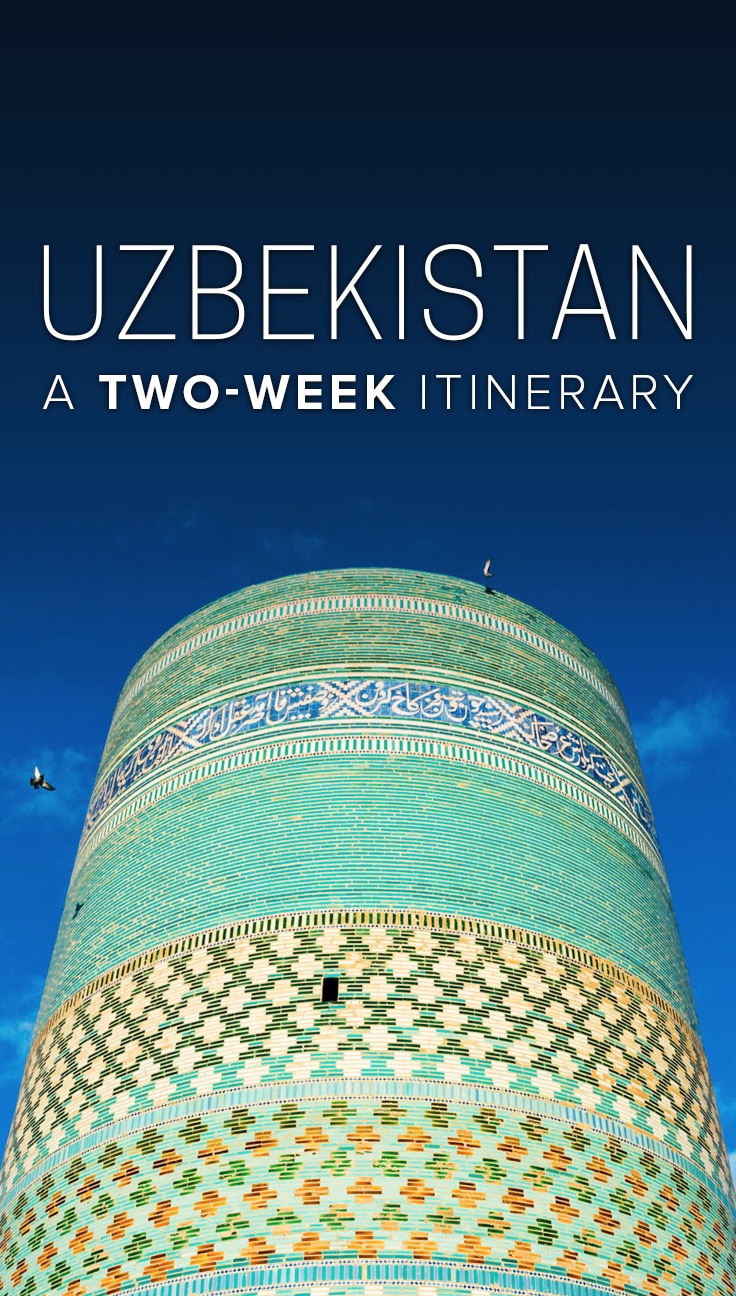
Might be useful? Pin it!
Complete two week Uzbekistan itinerary
Below you can find my recommendations for two weeks in Uzbekistan. This Uzbekistan itinerary will guide you to many of the highlights, but of course I also recommend some alternative destinations to get away from tourist crowds.
Pick and choose where you want to go, or you add some alternative destinations for a longer trip in Uzbekistan. You can also check out my overland itinerary for Uzbekistan and Tajikistan for more inspiration.
This itinerary also includes a guide to traveling in Uzbekistan, including information about money, transport, accommodation, and everything else you need to know for an epic trip to Uzbekistan.
Two weeks in Uzbekistan itinerary
- Day 1-2: Tashkent
- Days 3-5: Samarkand
- Days 6-8: Bukhara
- Days 9-11: Khiva
- Day 12-13: Nukus
- Day 14: Travel day
Alternative destinations in Uzbekistan
Guide to travel in Uzbekistan
Days 1-2: Tashkent
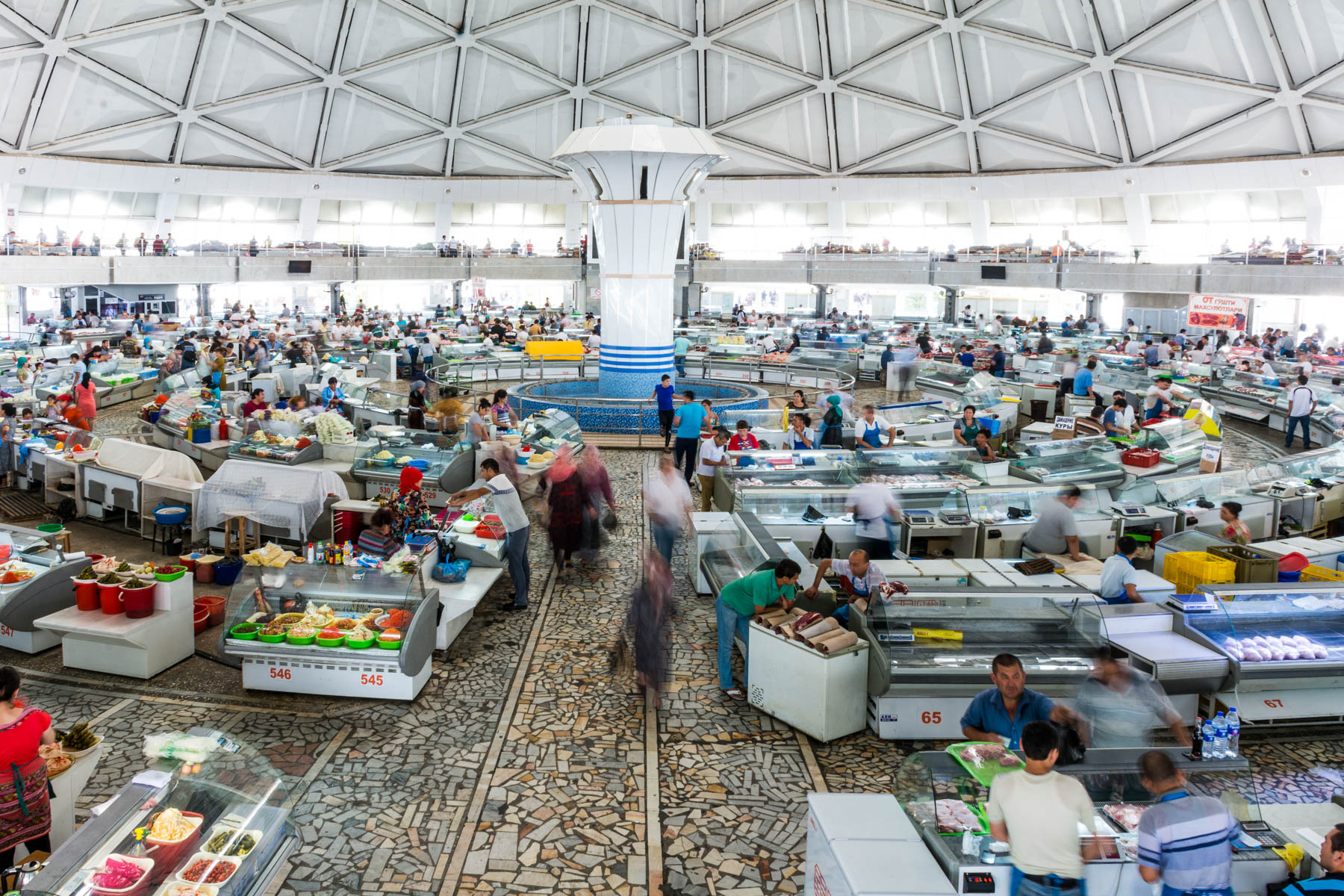
The meat and dairy market in Chorsu Bazaar
For most, Tashkent, the capital of Uzbekistan, is a rather underwhelming introduction to the country.
The city isn’t blessed with the jaw-dropping architecture that brings tourists to Uzbekistan (though you won’t know that… yet), and the sights available don’t exactly make up for that.
Regardless, it’s pleasantly tree-filled and easy to navigate, and this is where most people will start their visit to the country. There are still plenty of things to see in Tashkent.
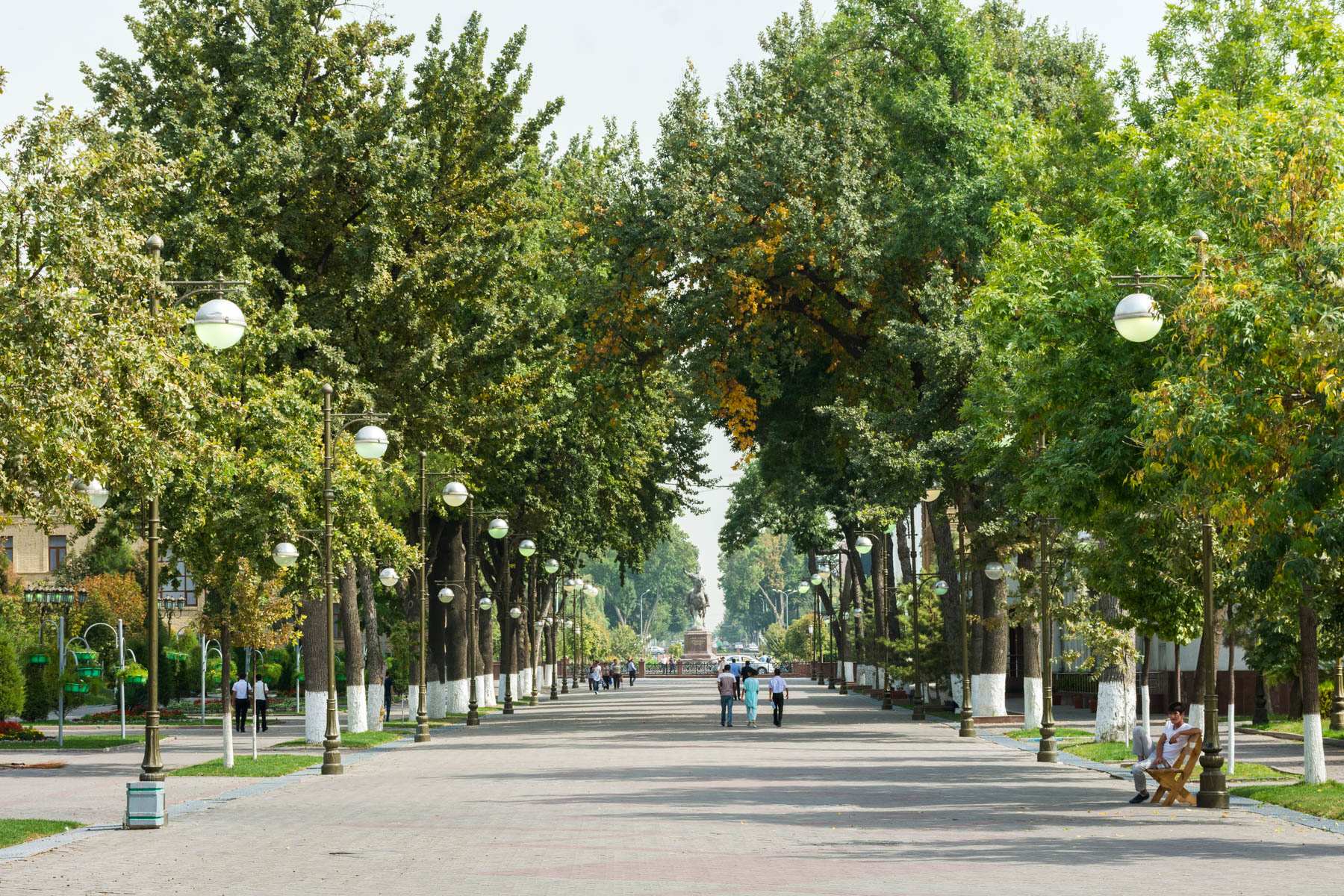
A boulevard in central Tashkent
Top things to see in Tashkent
- Tashkent Metro: A stunning remnant of the Soviet Era—and still expanding every year—some of the capital’s metro stations are works of art. I particularly enjoyed Alisher Navoi and Kosmonatavlar.
- Chorsu Bazaar: Tashkent’s main bazaar is a lively affair, with vendors selling everything from clothing to spices and vegetables.
- Amir Timur Museum: Museum dedicated to the warlord Amir Timur, who conquered most of Central Asia. A good stop for people interested in the man behind some of the most monumental buildings in the region, and founder of the Timurid empire.
- Hotel Uzbekistan: Not far from the Amir Timur Museum is Uzbekistan’s most famous hotel: the Hotel Uzbekistan. Not everyone’s cup of tea, this brutalist building is a dream for photographers who favor austere architecture.
- Kukeldash Madrasah: This madrasah (Islamic school) is by no means comparable with the ones in Samarkand or Bukhara. Regardless, it’s nice enough to warrant a visit, as it’s not far from Chorsu bazaar, and has a beautiful collection of old Korans in a building in the center of the complex.
- Plov Center: The place to eat plov, Uzbekistan’s favorite national food, in Tashkent.
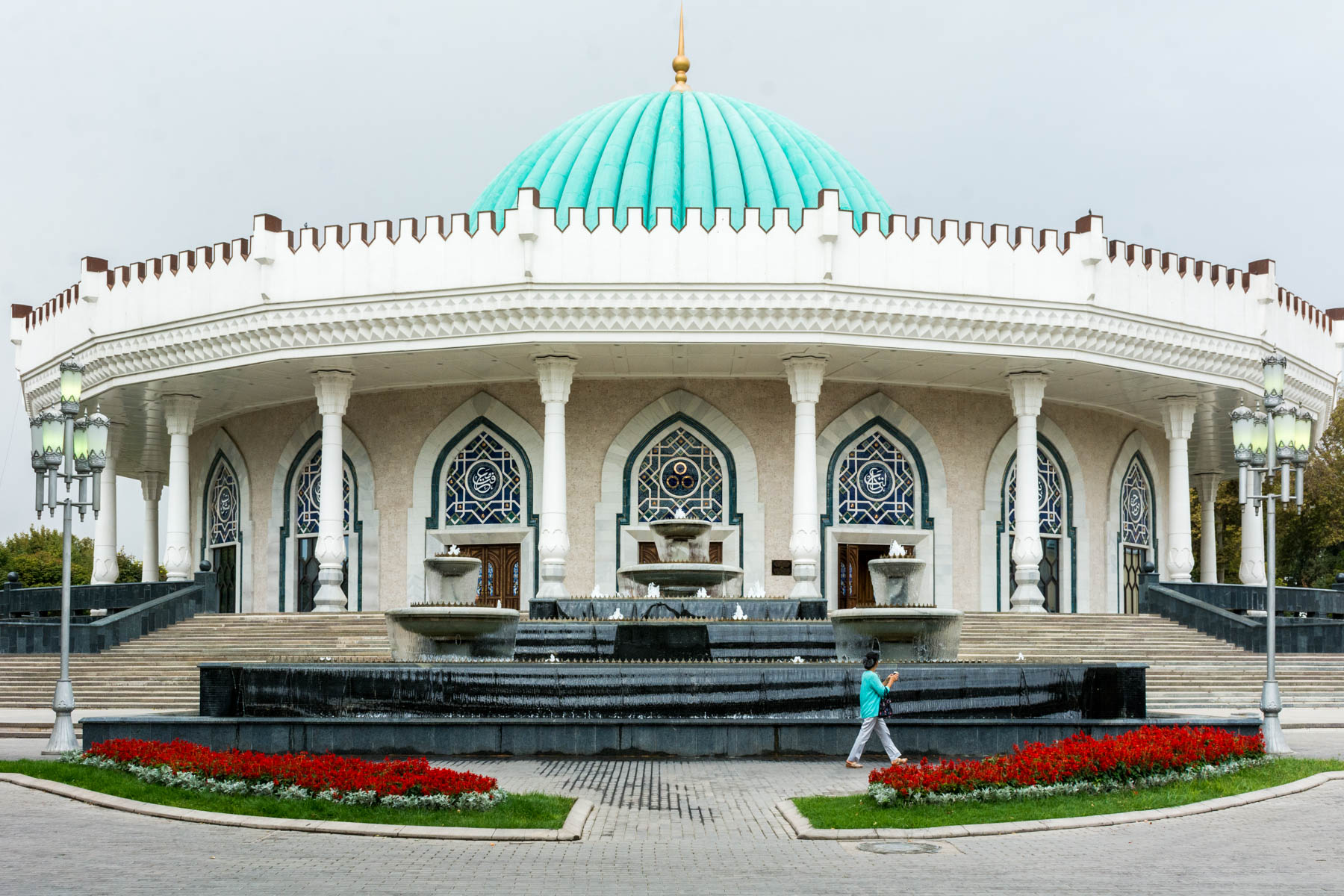
The Amir Timur Museum
Where to stay in Tashkent
- Budget: Topchan Hostel (where I stayed!) – Book Topchan Hostel now for the best deals
- Mid-range: Bo’ston Hotel – Interested? Book Bo’ston Hotel now
- Luxury: Ichan Qala Hotel – In need of some luxury? Check out the deals on Ichan Qala Hotel now
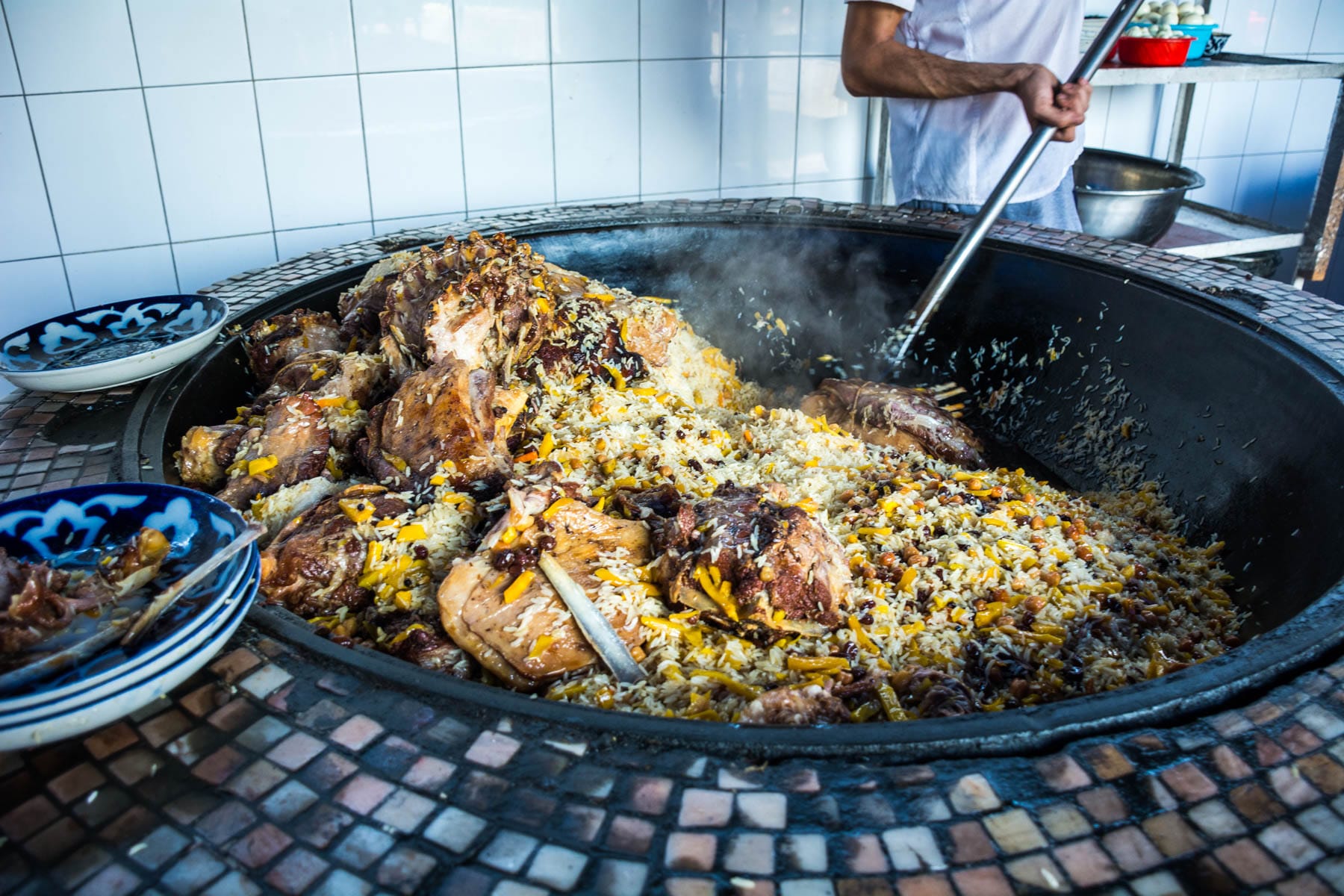
Plov a-cookin’ at the creatively named Plov Center
Getting around in Tashkent, Uzbekistan
Tashkent Metro
Tashkent has a convenient and cheap metro system, although using it might seem daunting at first. Your bags are usually scanned before entering the metro station, and there are plenty of police around. Rest assured, they aren’t there to hassle you; just make sure no one misbehaves. Note that as of 2018, taking pictures of the metro stations is allowed.
- A useful map of the main metro lines can be found here
- Tickets cost 1,200 som (US$0.15) regardless of destination
Taxis in Tashkent
Any car in Tashkent can be a taxi. Stand on the side of the road and hold your hand out, and a car will usually stop within minutes. If the driver is heading your way or feels like heading there, you can hop in. Make sure to agree on a price beforehand.
The driver will usually want you to make the first offer. If your offer is fair most drivers will agree with the price quickly. Ask your hotel or a friendly local what a reasonable price should be for your intended destination.
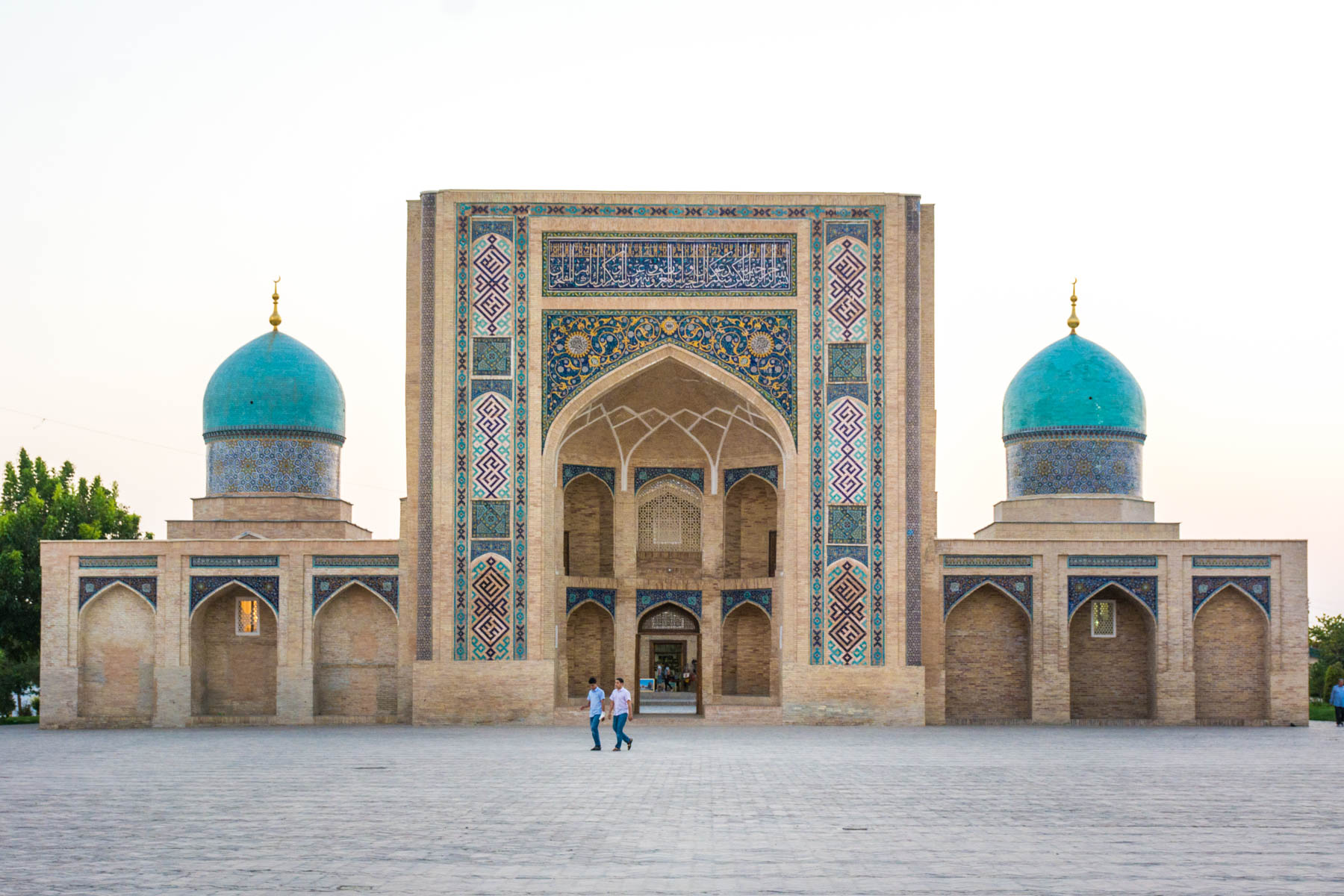
Kukeldash madrasah at sunset
Transportation from Tashkent
- Train from Tashkent to Samarkand: 2-4 hours
- Plane from Tashkent to Samarkand: 1 hour
- Shared taxi from Tashkent to Samarkand: 4 hours
Days 3-5: Samarkand
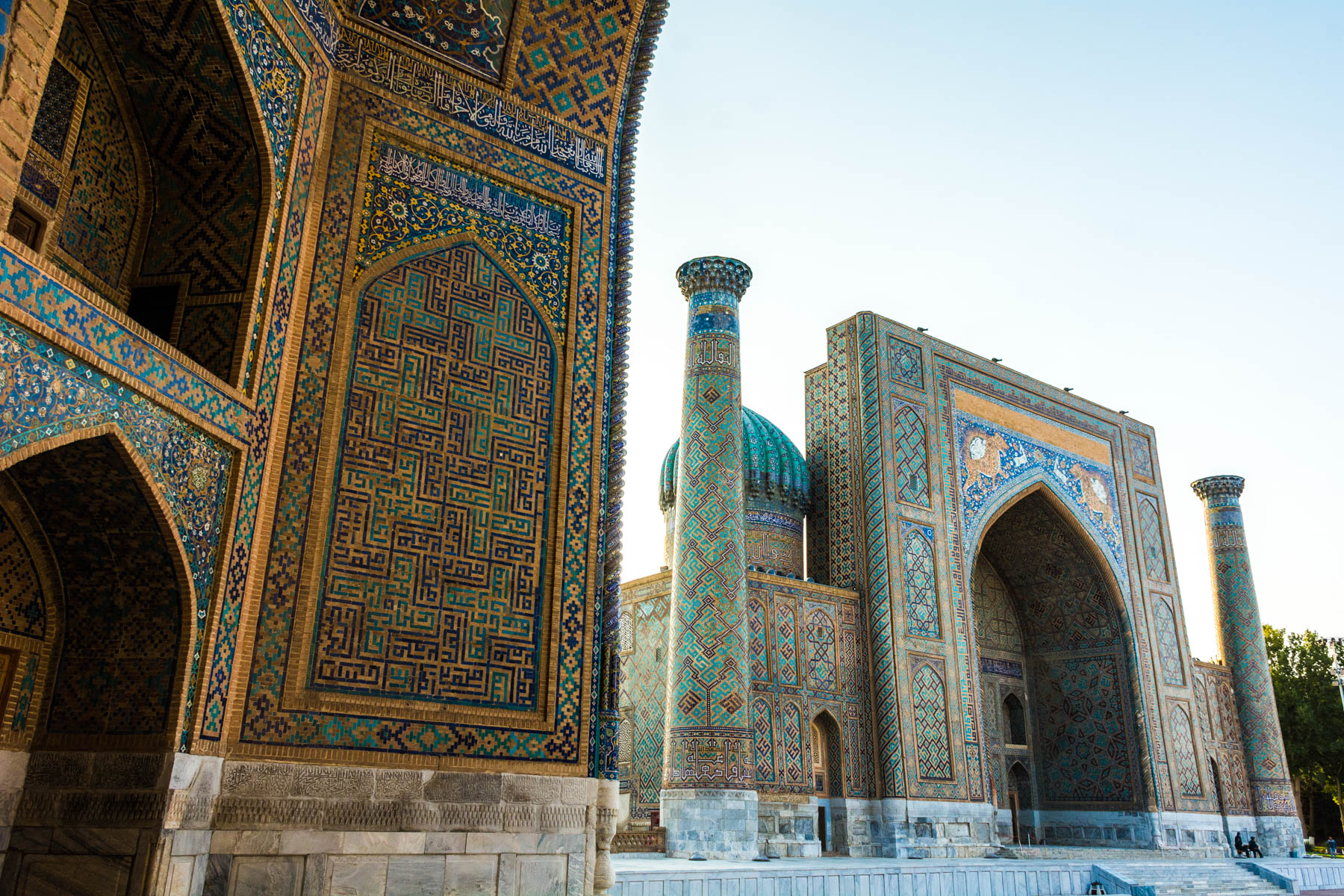
The magnificent Registan at sunrise
Samarkand is a definitive highlight of any trip to Uzbekistan. The first time you see the Registan is a moment you won’t soon forget! I highly recommend you visit the Registan at sunrise.
Although the city can feel a bit crowded and touristy at times, it’s easy to retreat to the winding back alleyways to get away from it all.
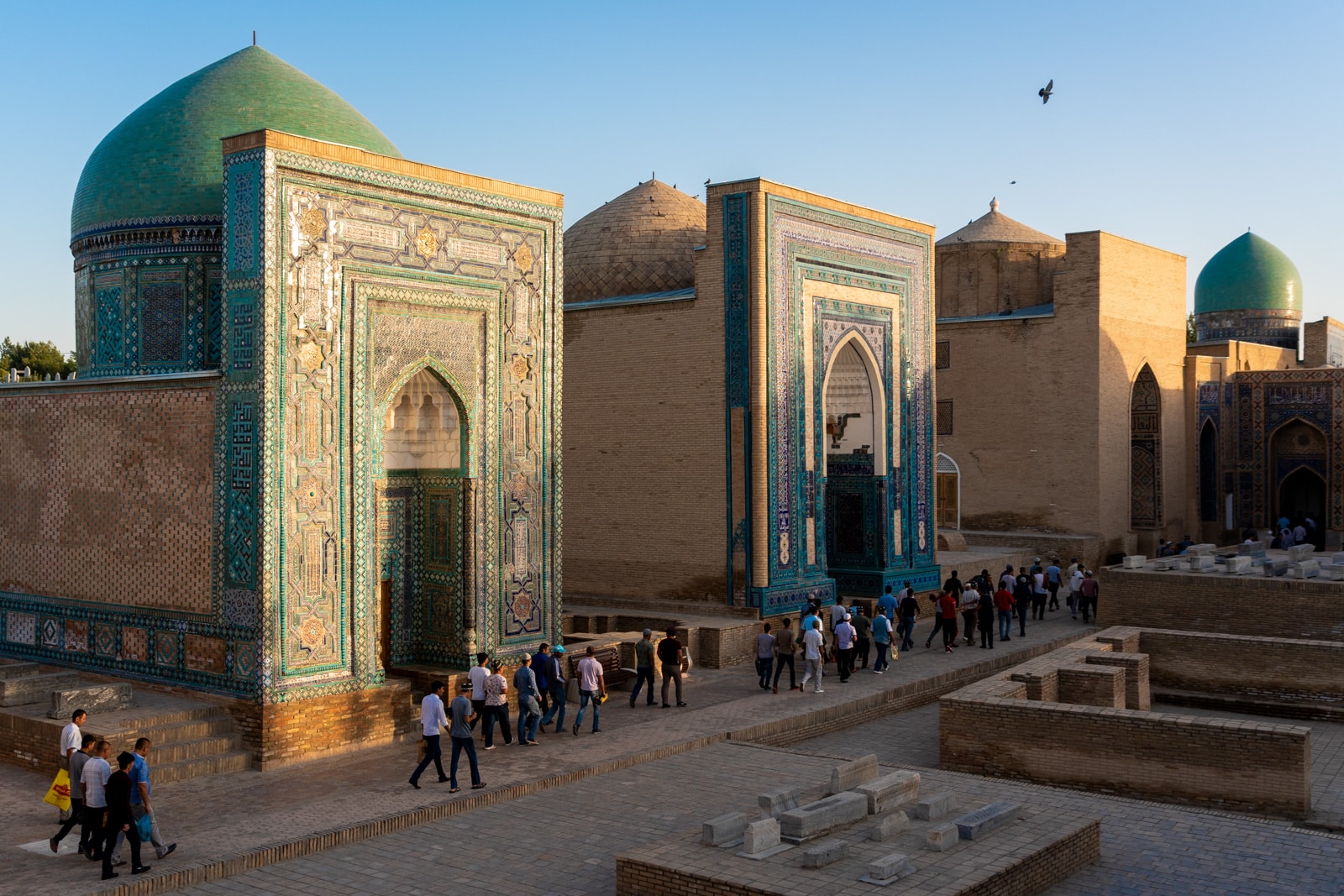
Men walking through the Shah-i-Zinda necropolis after morning prayers during Eid
Top things to see in Samarkand
- Registan: The three madrasahs that make up the Registan are a sight to behold. Hands down they’re some of the most incredible buildings in Central Asia. Just writing about them still gives me goosebumps. The magnificence of the Registan is best sampled at dawn, as the souvenir shops during the day take away some of its appeal. There’s also a light show in the evening every once in a while; hang out a bit after sunset to see if it’s on.
- Gur-e-Amir: The mausoleum to Tamerlane (Timur) is built in a distinctly Timurid fashion, with blue onion domes and plenty of elaborate tile work. Fun fact: Timur’s grave is actually buried in a vault deep below the main mausoleum.
- Shah-i-Zinda: Necropolis for many a ruler and their offspring. Visit in the late afternoon, when it’s least busy. It’s possible to enter for free, using one of the entranceways to the adjoining cemetery. The cemetery also offers a nice vantage point into the necropolis.
- Bibi Khanym Mosque: Once one of the largest mosques in the world, large parts of it were destroyed over time. Restoration efforts have given it some of its shine back, though, and it’s still a sight to behold.
- Siyob Bazaar: The largest bazaar in the country is easily found right next to the Bibi Khanym mosque. It’s a great place to wander, whether you’re on the hunt for fresh produce (a rarity in Uzbek restaurants) or just want to bask in the bustle.
- Afrasiyab ruins: Ruins of an ancient city to the north of modern-day Samarkand. You’ll need your imagination, but it’s not every day you can wander freely through civilization ruins more than a thousand years old.
There are many more sights in Samarkand, too many to mention here. I recommend exploring Samarkand leisurely, to really soak in one of the grandest cities of the Silk Road.
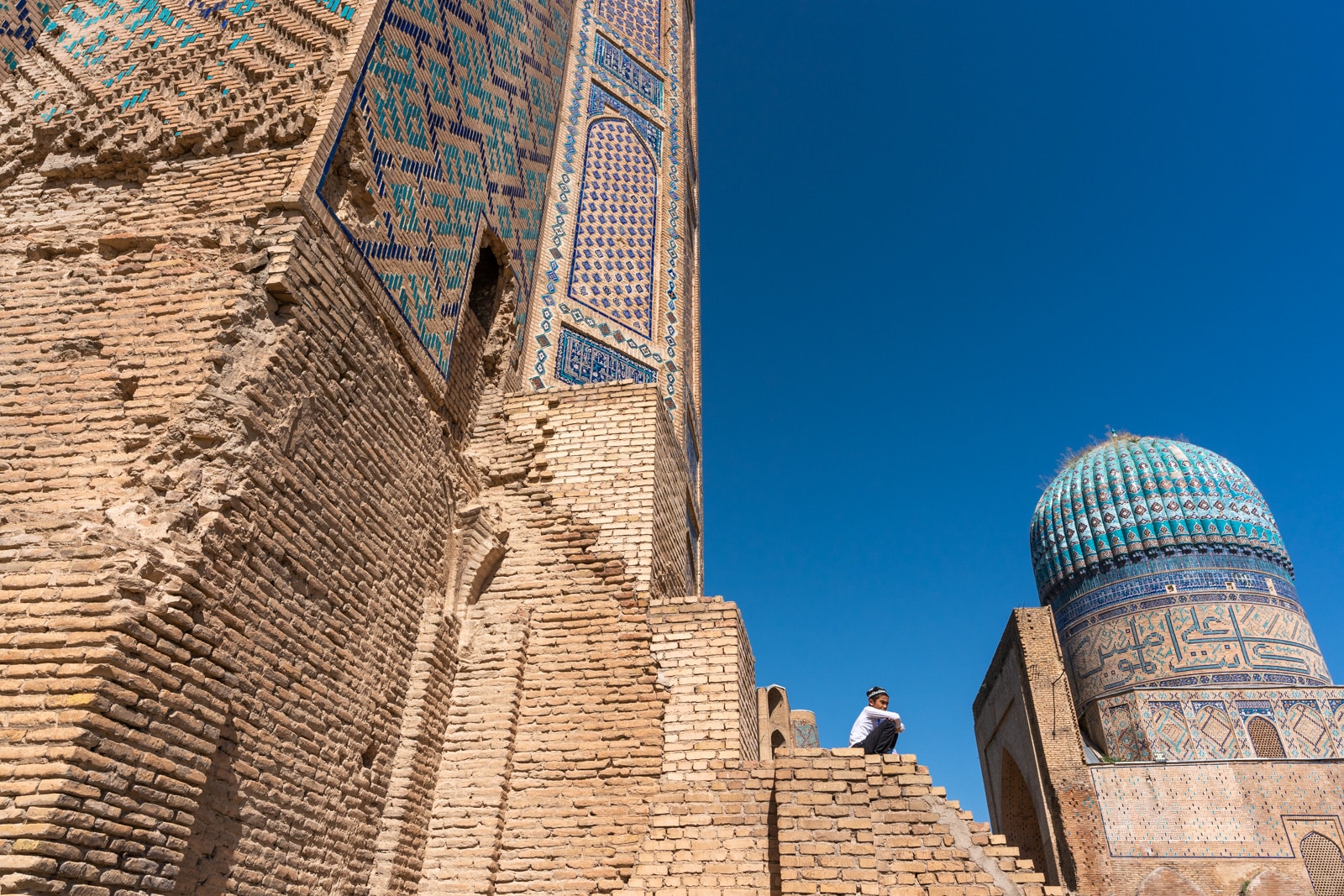
An Uzbek schoolboy casually chilling on the Bibi Khanym mosque
Where to stay in Samarkand
- Budget: B&B Bahodir – Book B&B Bahodir now
- Mid-range: Jahongir B&B – Book a room at Jahongir B&B
- Luxury: Grand Samarkand Superior – Looking for the best deals? Check them out for Grand Samarkand Superior now
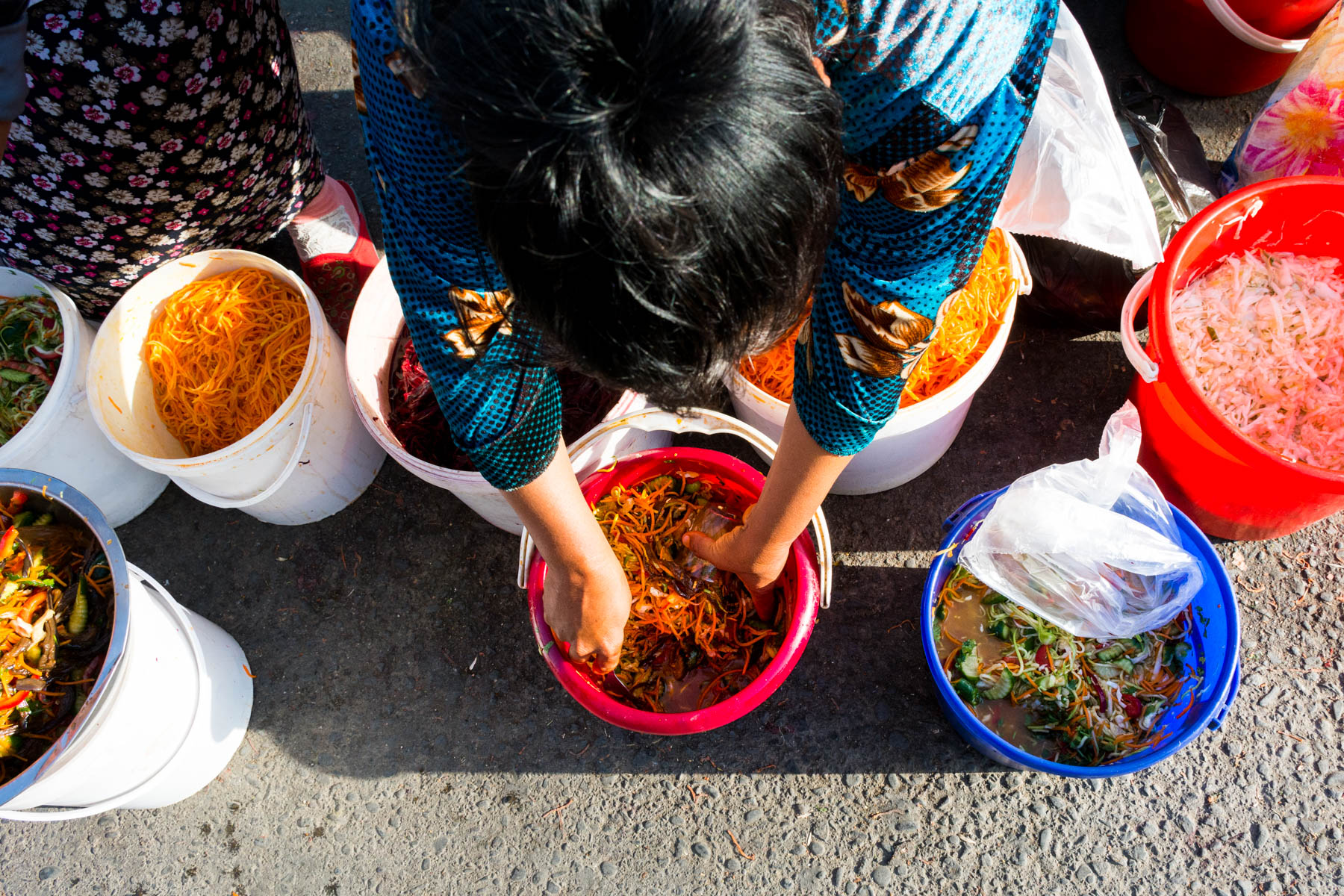
A salad vendor peddling her wares at the Siyob Bazaar
Transportation from Samarkand
- Train from Samarkand to Tashkent: 2-4 hours
- Train from Samarkand to Bukhara: 2-3 hours
- Shared taxi from Samarkand to Bukhara: 4 hours
- Bus from Samarkand to Bukhara: 5-6 hours
- Train from Samarkand to Khiva: 12 hours
Days 6-8: Bukhara
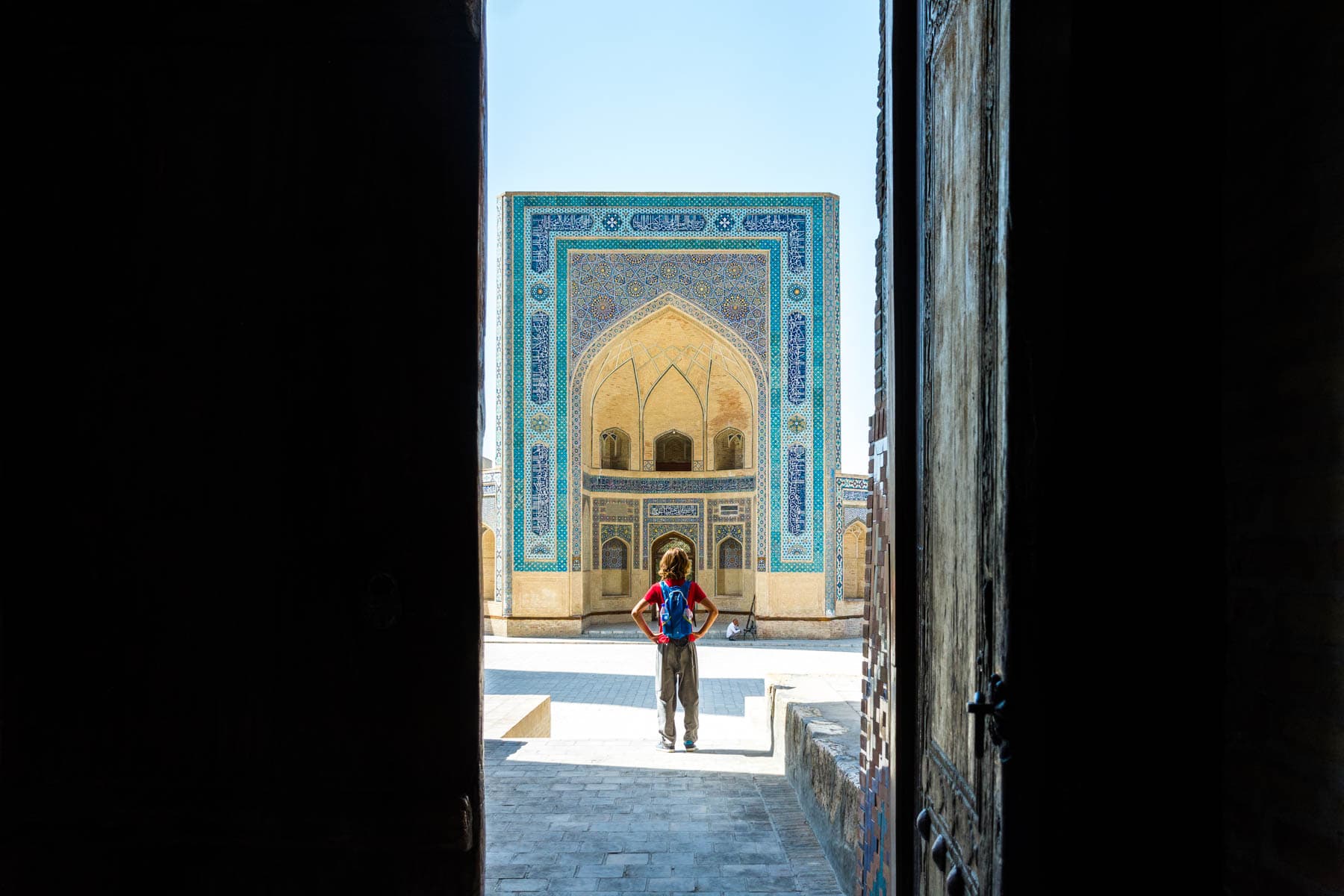
Looking out over the Kaylan Mosque
Bukhara is a perfect place to get lost in; I recommend just that. Though Samarkand is the grandest of Uzbekistan’s cities, Bukhara is the more historically significant of the two; it was the hub of art and science in Central Asia during the Silk Road era.
Most tourists stick to the main sights, but the back alleys are full of surprises and make for a great afternoon of leisurely exploration. Wander for a while, occasionally refuel with a cold beer and some pumpkin manti (dumplings with pumpkin), and you’ll be good to go again.
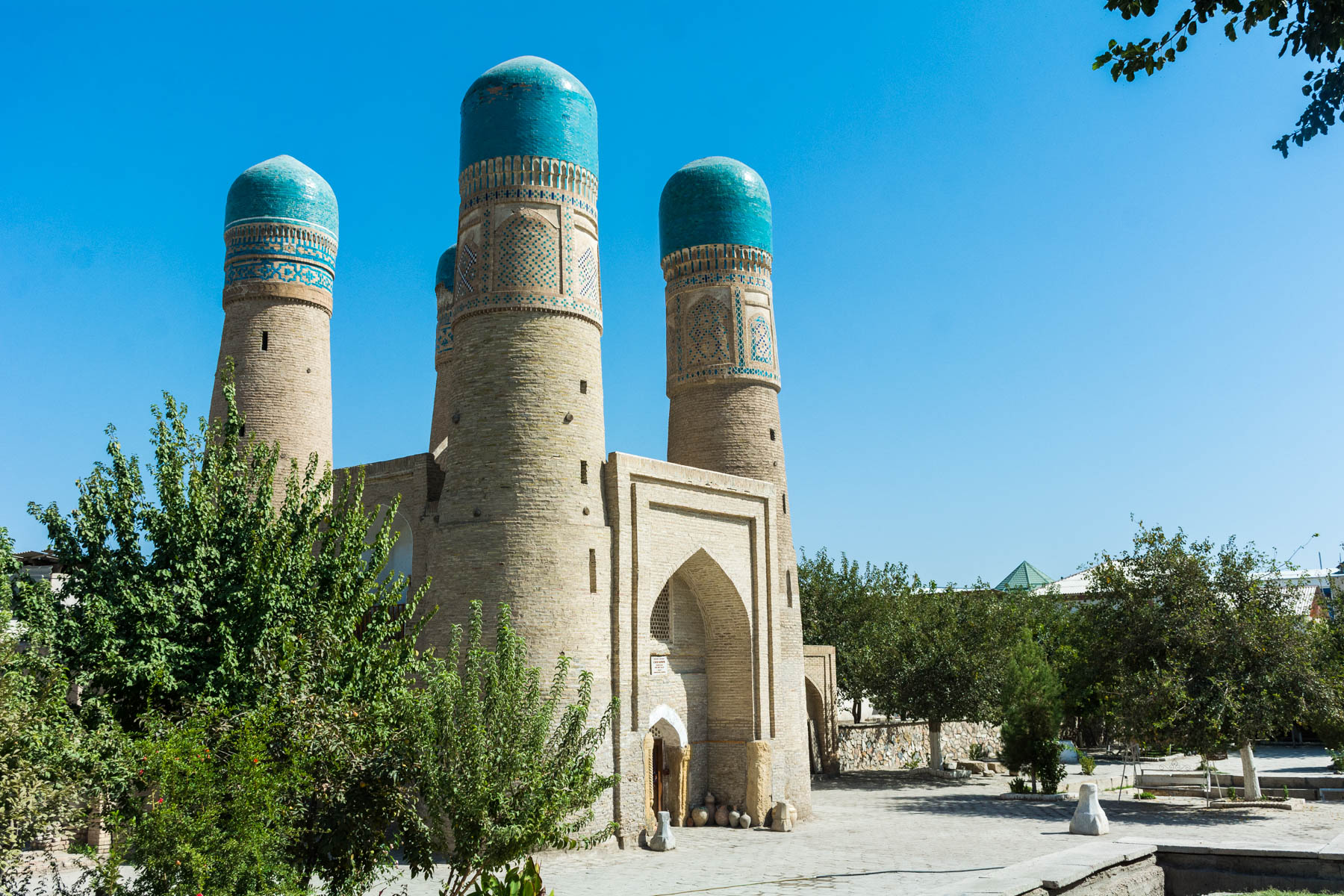
The charming Chor Minor
Top things to see in Bukhara
- Po-i-Kalyan: One of Uzbekistan’s greatest architectural ensembles, the Po-i-Kaylan houses the Kaylan Minaret, the Kaylan Mosque, Miri-Arab Madrasah, and Amir-Allimkhan Madrasah. Though I’m not one for tourist restaurants, Chasmai Mirob is a rooftop restaurant with a stunning view over the complex (that also offers pumpkin manty!).
- Chor Minor: Meaning “four minarets”, this charming little former madrasah gatehouse now houses a souvenir stall.
- Ark of Bukhara: A massive fort, of which a small part is open to the public. Though not as impressive and surprisingly lacking in views despite the high vantage point, it houses some interesting exhibitions that will give you a bit of background context into Uzbekistan’s history.
- Lyab-i-Hauz: Though a bit touristy, Bukhara’s main square houses some exquisite buildings and is a perfect place for an afternoon ice cream or drink as you people watch.
- Bolo Hauz Mosque: A stunning mosque with exquisitely decorated wooden ceiling panels and columns.
You could see Bukhara in two days, but since getting there can take some time I recommend at least three days. One of Uzbekistan’s joys is wandering about the back alleys of the cities, away from tour bus crowds; Bukhara is perfect for exactly that.
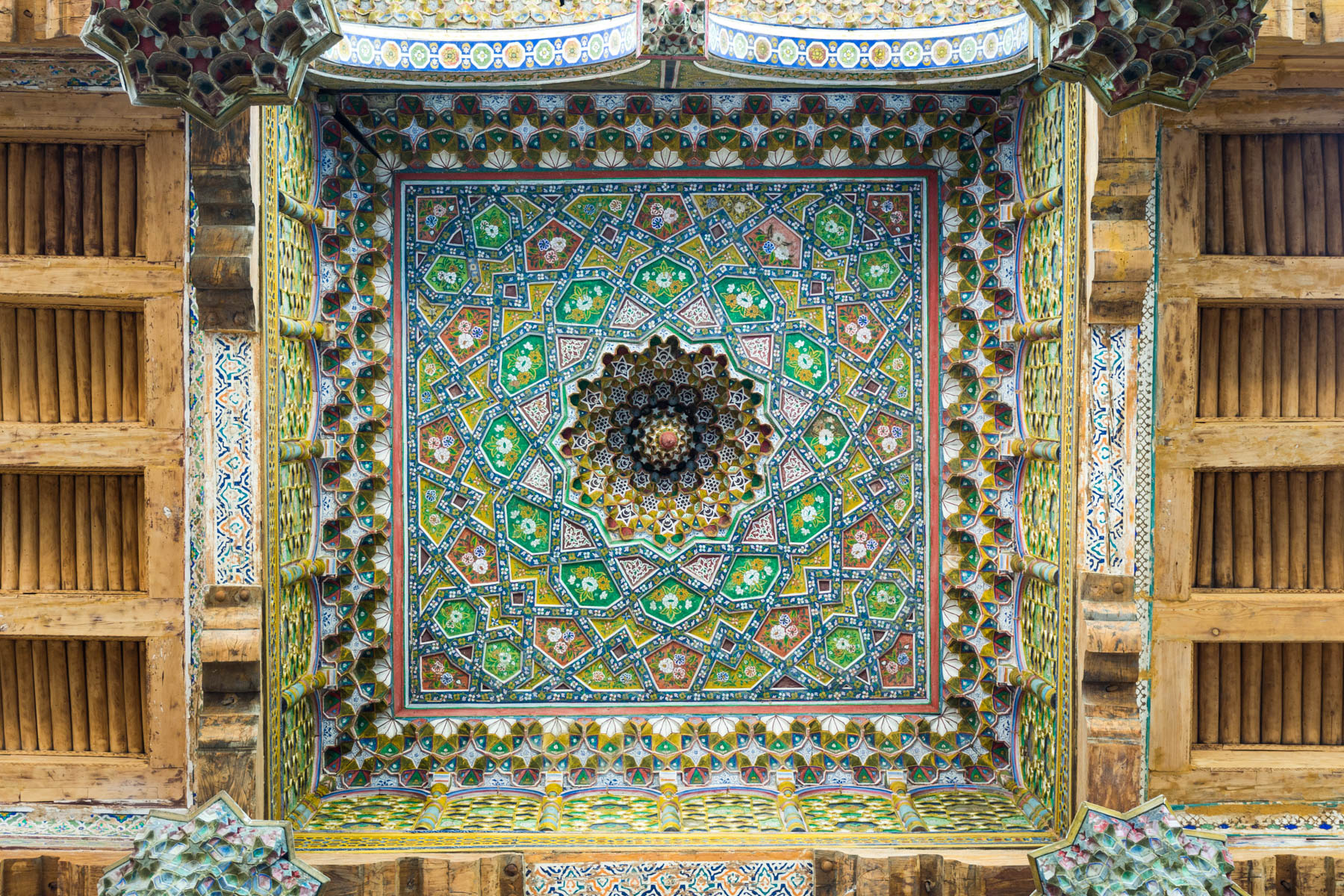
One of the many stunning ceiling panels of the wooden Bolo Hauz mosque near the ark.
Where to stay in Bukhara
Bukhara has the greatest concentration of guesthouses and homestays in the country. It pays to look around the internet to see what strikes your fancy—Booking.com is a good place to find accommodation in Bukhara. English isn’t always spoken in budget places, but considering how friendly everyone is, this hardly matters!
- Budget: Jeyran Hotel – Book Jeyran Hotel now
- Mid-range: Chor Minor Hotel – Have a look at Chor Minor Hotel
- Top end: Komil Boutique Hotel – Indulge with Komil Boutique Hotel
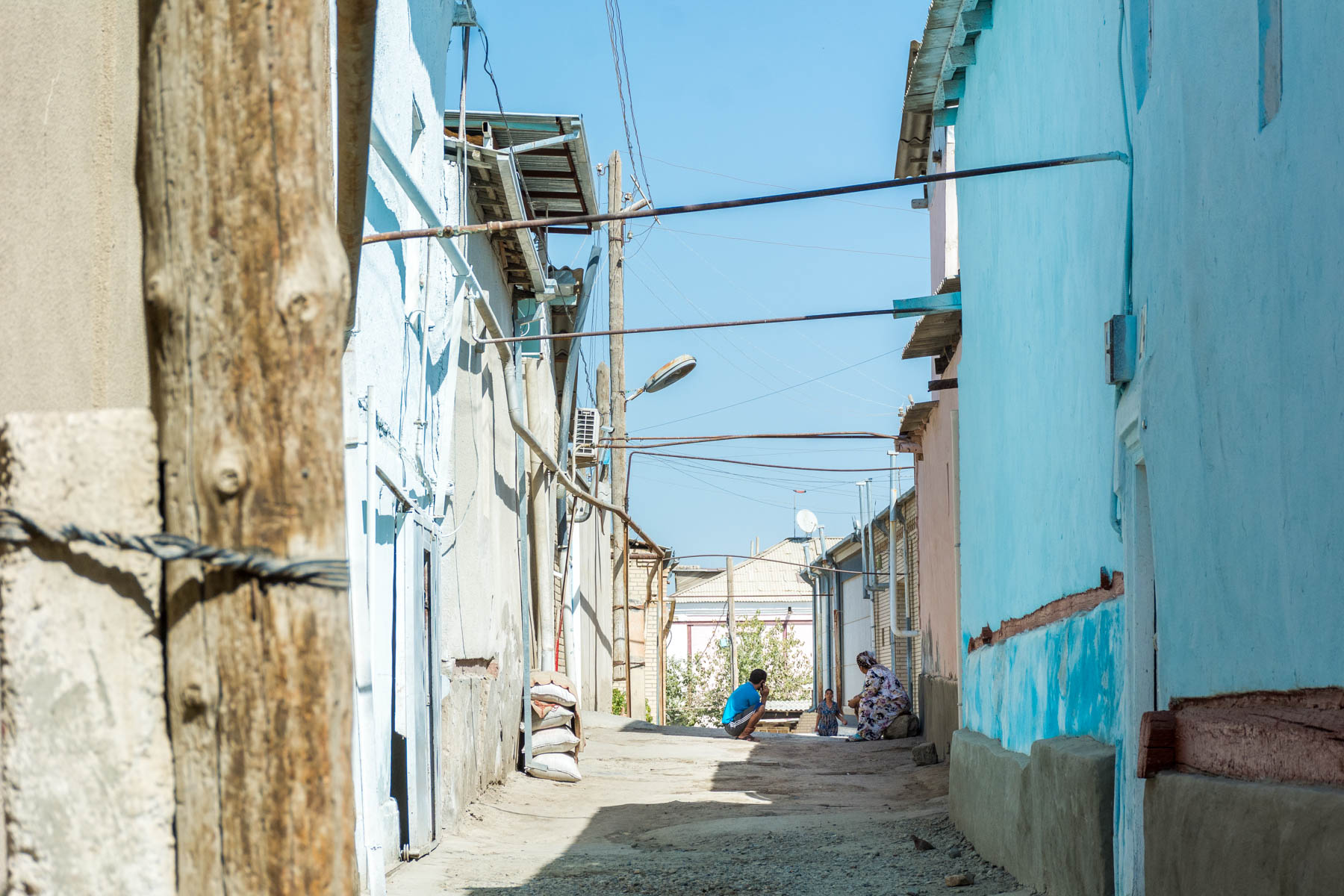
Taking a break in Bukhara’s back alleys
Transportation from Bukhara
Note that previously Bukhara was not connected to Khiva by train… but as of 2018, there’s now a train line connecting the two cities!
- Train from Bukhara to Samarkand: 2-3 hours
- Shared taxi from Bukhara to Samarkand: 4 hours
- Bus from Bukhara to Samarkand: 5-6 hours
- Train from Bukhara to Tashkent: 6.5 hours
- Train from Bukhara to Khiva: 6 hours
- Bus from Bukhara to Khiva: 8 hours
- Shared taxi from Bukhara to Urgench (Khiva): 7 hours
Days 9-11: Khiva
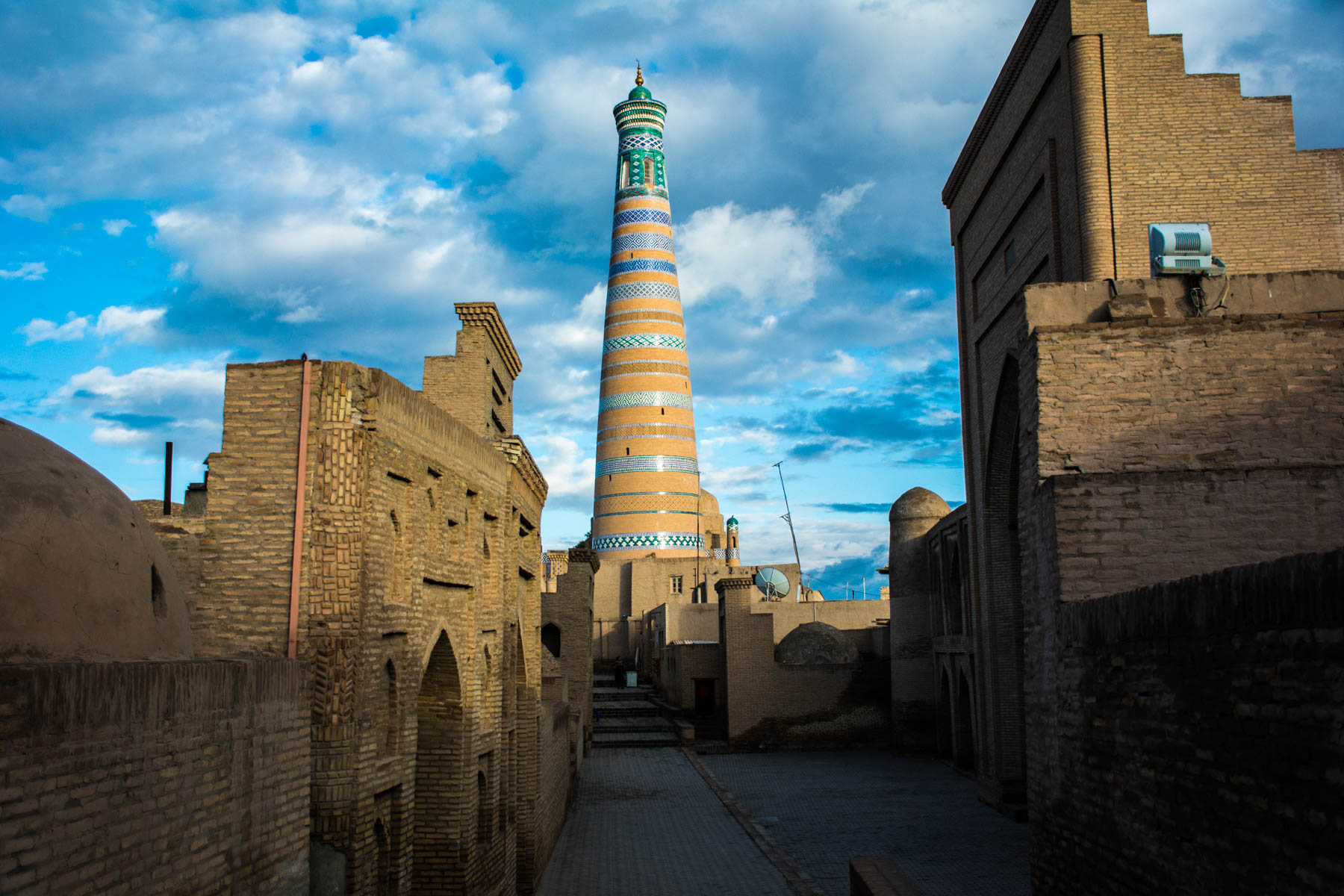
The Tura Murad Minaret. You can scale this beaut for epic views over Khiva.
Khiva, a UNESCO World Heritage Site, is a unique town in Uzbekistan. It’s so well preserved, it’s almost museum-like! The old town is one huge historic playground and a photographer’s dream.
I recommend staying in Khiva at least two days to make sure you can soak up sights at a leisurely pace and perhaps go for a foray into some of the nearby villages. Most sights can be entered on a combined entrance ticket, sold at the main entrance to the old town.
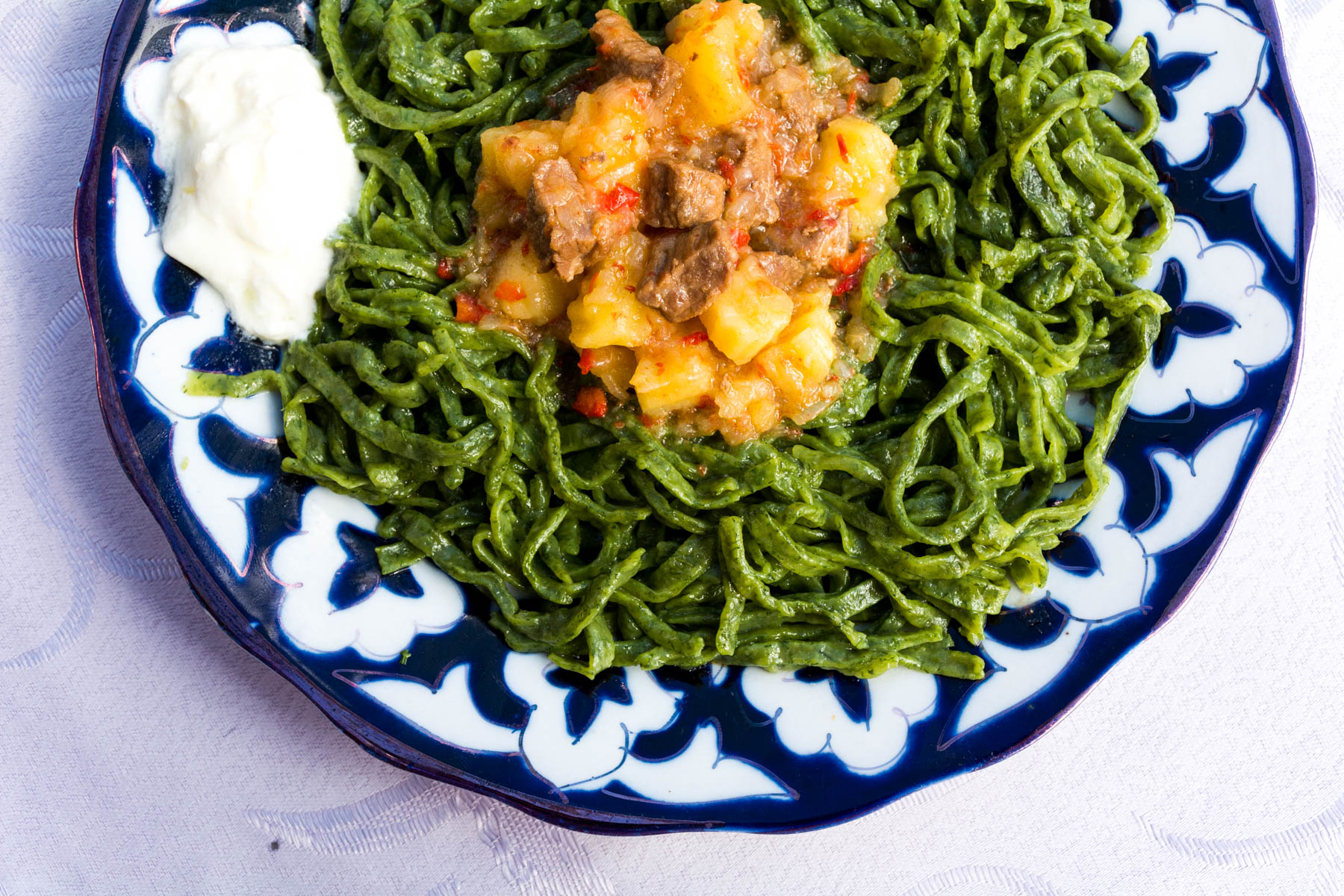
Tip: Don’t miss a chance to try shivut oshi (green noodles), a local specialty made with dill-infused dough. The color’s a bit disconcerting, I know, but never fear, they’re delicious. And that’s coming from someone who despises dill.
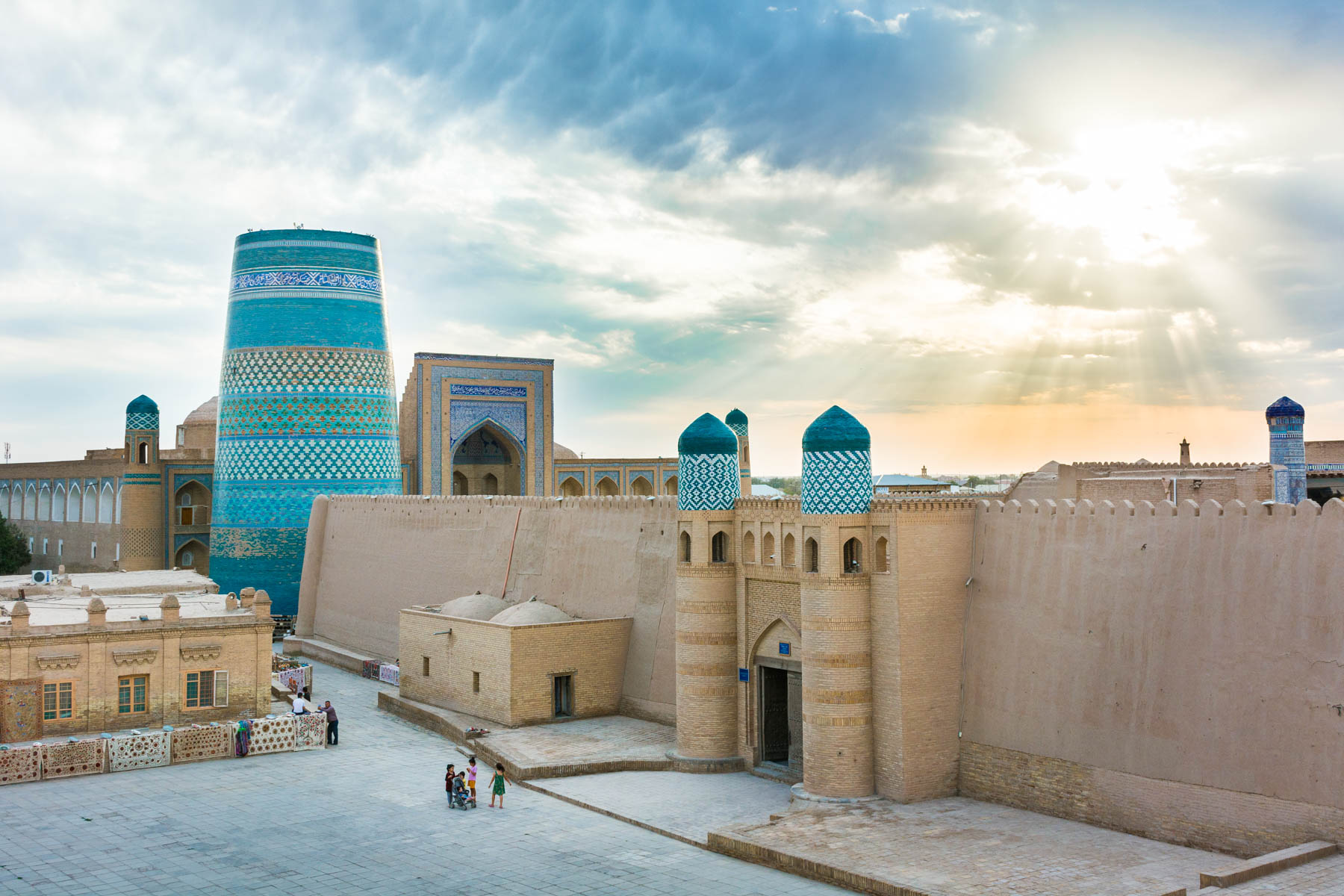
An epic sunset over Khiva’s old city.
Top things to see in Khiva
- Itchan-Kala: Khiva’s historic old town, and the place you’ll spend most of your time. Basically an open-air museum. Make sure to get up early one day to see the sunrise from the city wall.
- Muhammad Aminkhan Madrasah: The largest madrasah in Central Asia now houses a luxury hotel, but is still a sight to behold.
- Kalta Minor Minaret: Unfortunately it’s not possible to enter this unfinished minaret next to the Muhammad Aminkhan Madrasah anymore. Regardless, it’s synonymous with Khiva, and you can’t miss it.
- Tura Murad Minaret: A towering minaret in one of the corners of the Old City, which you can climb for 5,000 som (separate from the general old city entry ticket).
- Pakhlavan Makhmud Mausoleum: Another one of the few sights in Khiva ticketed separately, this mausoleum is an interesting stop.
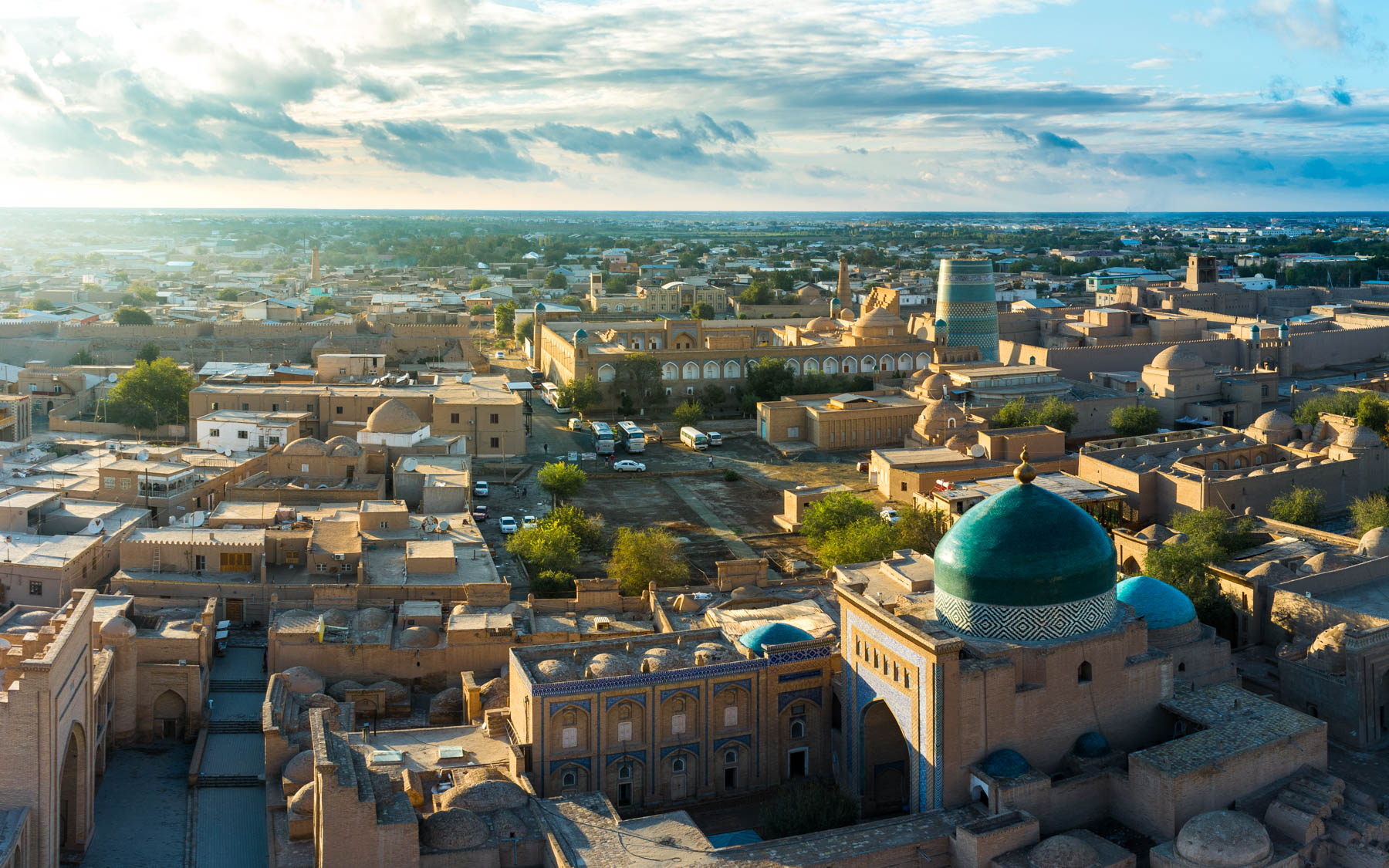
What’s the point in trying to describe views like this?
Where to stay in Khiva
- Budget: Laliopa Guest House – Book Laliopa Guest House here
- Mid-range: Hotel Old Khiva – Check out Hotel Old Khiva now
- Top end: Hotel Shaherezada – Find the best deals for Hotel Shaherezada
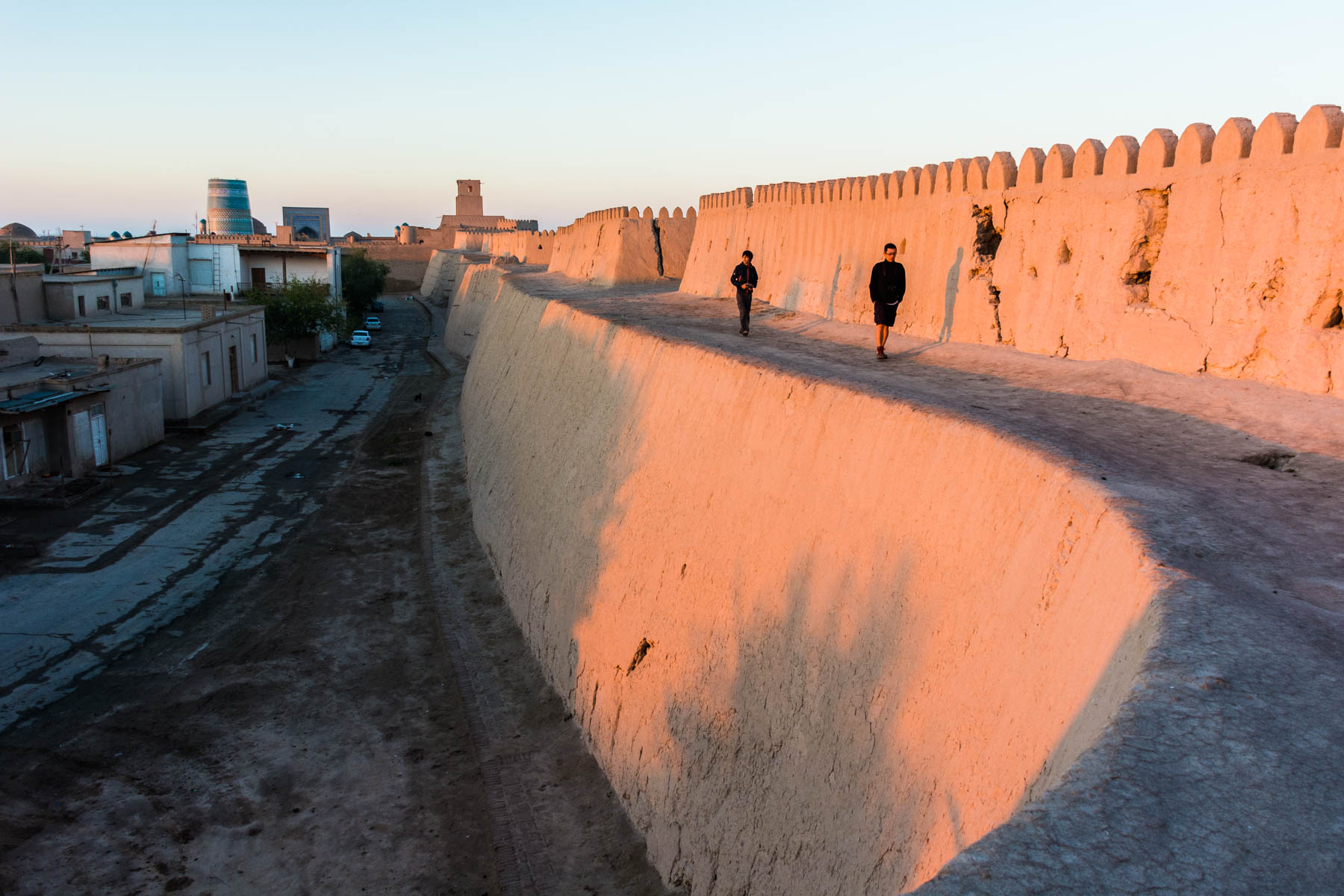
The extensive walls around Khiva’s old city are free to climb, and are a perfect spot to catch some epic sunrises!
Transportation from Khiva
- Flight from Khiva to Tashkent: 1.5 hours
- Train from Khiva to Bukhara: 6 hours
- Train from Khiva to Tashkent: 16 hours
- Train from Khiva to Samarkand: 12 hours
- Shared taxi to Nukus: 3 hours
Days 12-13: Nukus
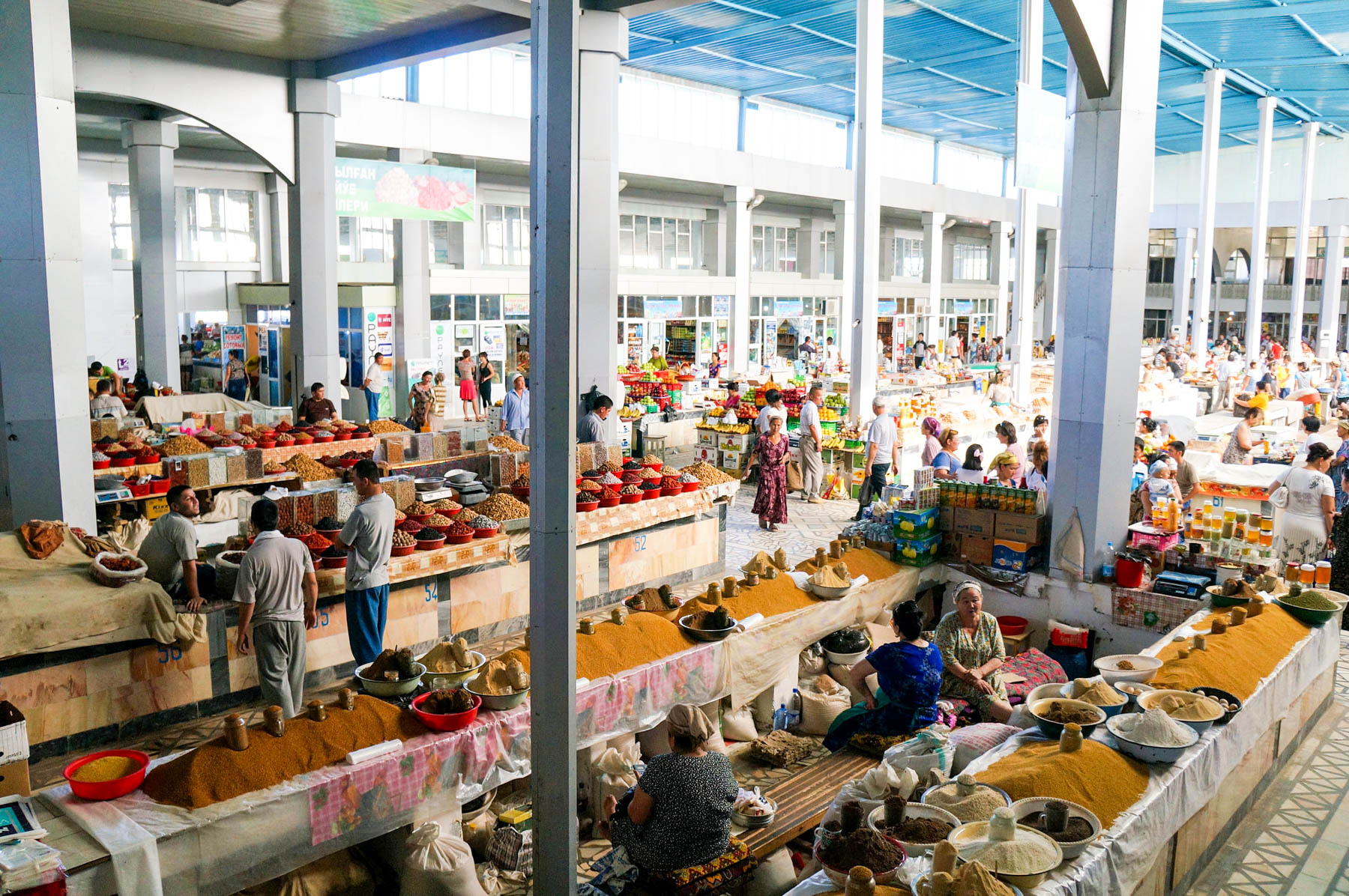
Nukus bazaar by mrhicks46
Nukus, home to the Savitsky Karakalpakstan Art Museum, is a bit of an oddity. It’s the capital of the autonomous Karakalpakstan region, a little-visited part of Uzbekistan. There is not so much to do in Nukus, but art lovers cannot miss the museum, which houses one of the finest art collections in Central Asia.
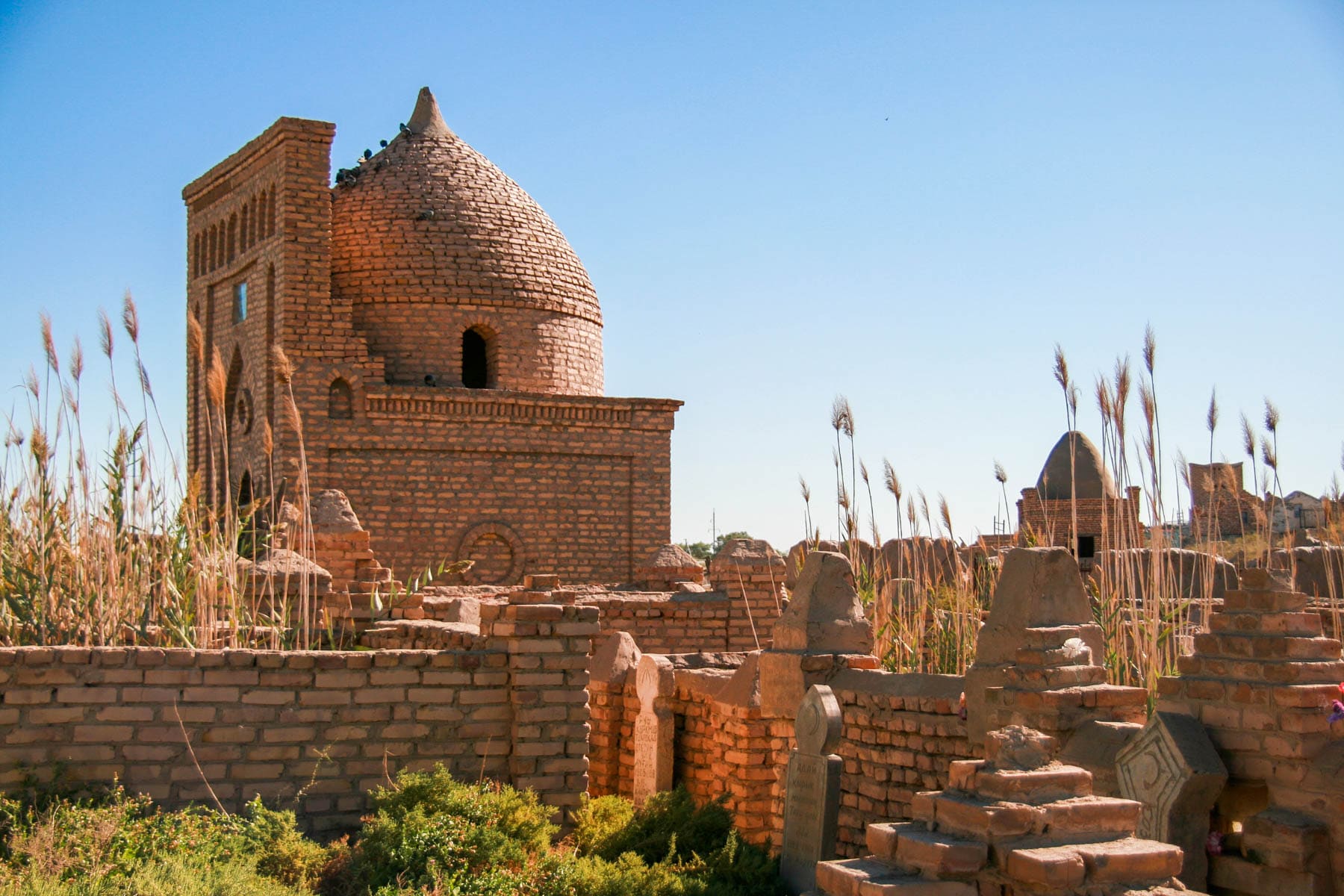
The Mizdakhan necropolis by kvitlauk
Top things to see in Nukus
- Nukus Museum of Art: An art museum founded by The Russian painter, archeologist, and collector, Igor Savitsky. It houses one of the finest art collections in the entire region.
- Mizdakhan Necropolis: An ancient cemetery outside of Nukus with a mixture of Islamic and Zoroastrian influences.
- Moynaq: An abandoned fishing village outside of Nukus, along the dried-up Aral Sea. More about it in the “Alternative destinations” section below.
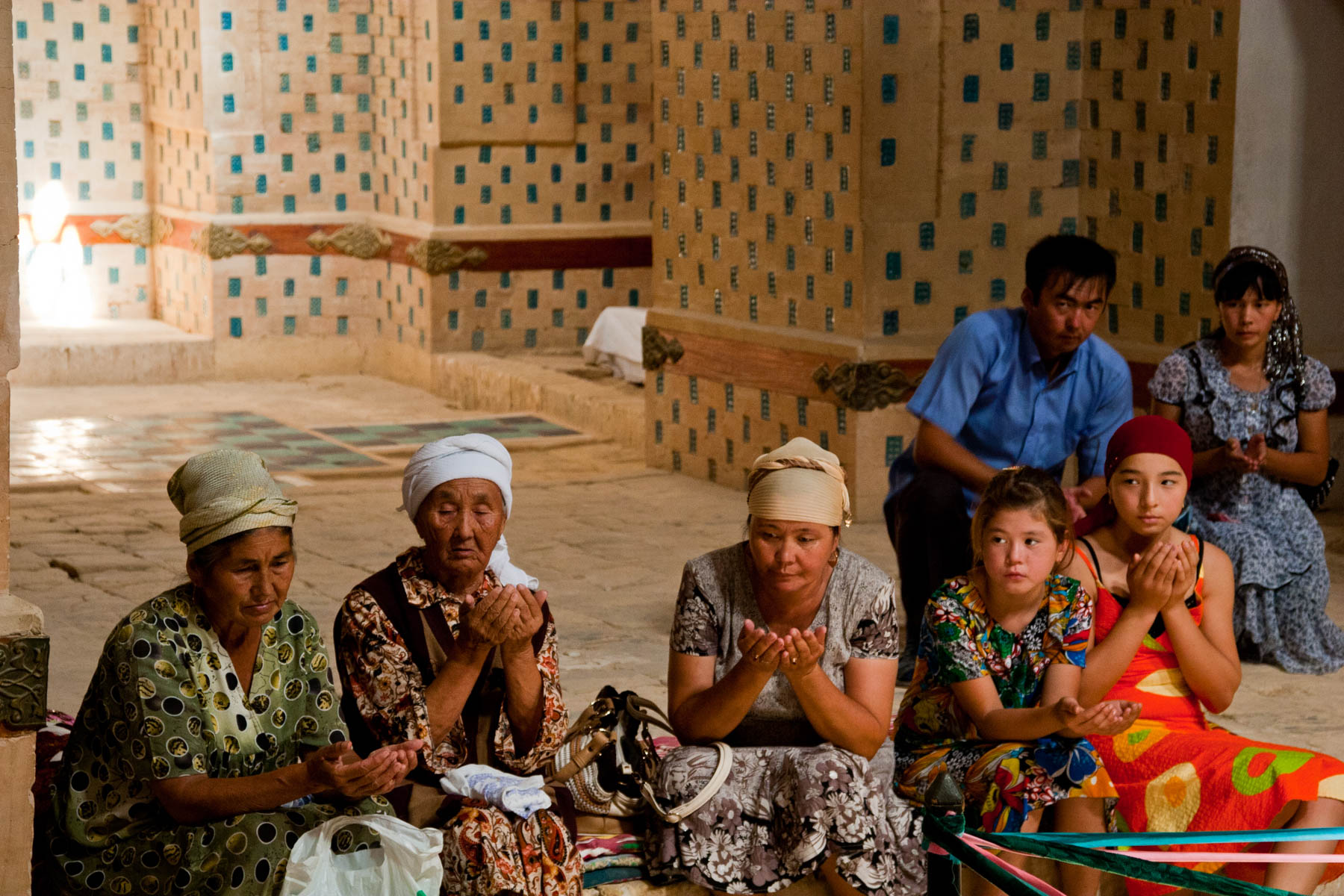
A family praying in the Mizdakhan necropolis by Ismael Alonzo
Places to stay in Nukus
- Budget: Hotel Nukus
- Mid-range: Jipek Jolly – Book Jipek Jolly now
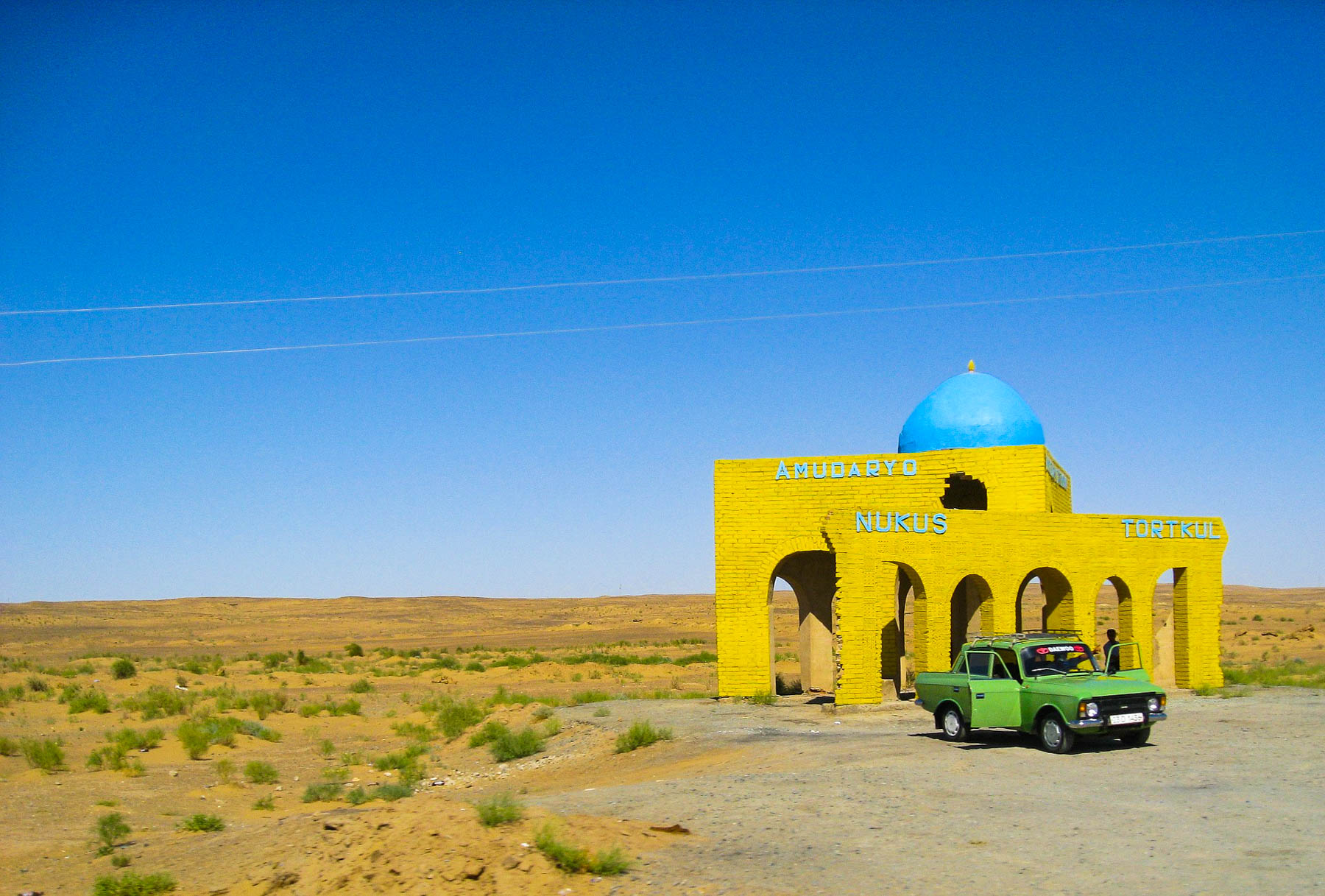
The desert near Nukus
Transportation from Nukus
Nukus could theoretically be done as a day trip from Khiva, but only if you hire a private taxi. Shared taxis tend to fill up slowly.
- Shared taxi from Nukus to Khiva: 3 hours
- Flight to Tashkent: About 2 hours
Day 14: Travel day
Since traveling in Uzbekistan can take more time than you’d think, I left one day open in this two week Uzbekistan itinerary.
If you end up in Nukus and need to head back to Tashkent quickly, the best option is to fly back from Khiva. Otherwise, an overnight train from Khiva to Tashkent will do the trick.
If you want to travel to other Central Asian countries, I highly recommend traveling over land into neighboring Tajikistan for an epic mountain adventure. Crossing overland has gotten significantly easier in recent years, and Tajikistan is a dream. You can find more on how to cross from Uzbekistan into Tajikistan from Samarkand in my Uzbekistan-Tajikistan itinerary.
If you have more time for travel in Uzbekistan, read on for more off the beaten track places in Uzbekistan that might be of interest.
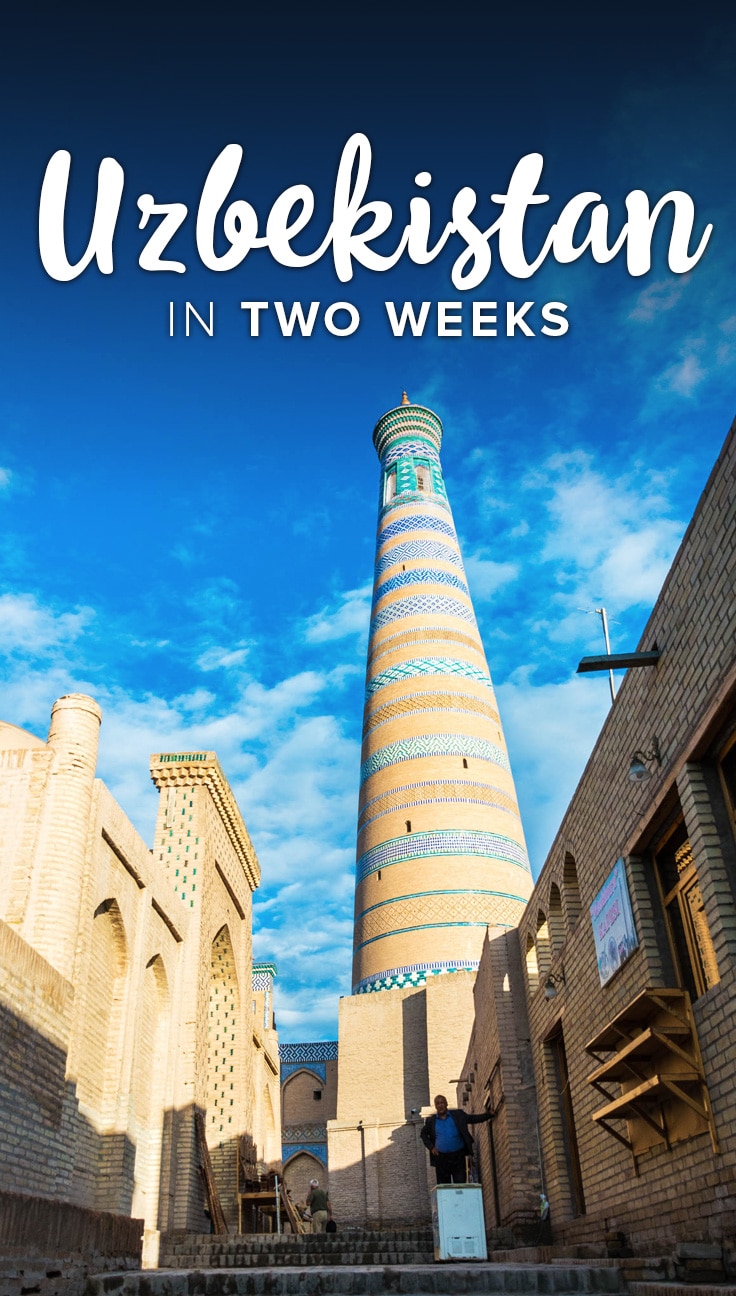
Liking this? Pin it!
Alternative destinations for your Uzbekistan itinerary
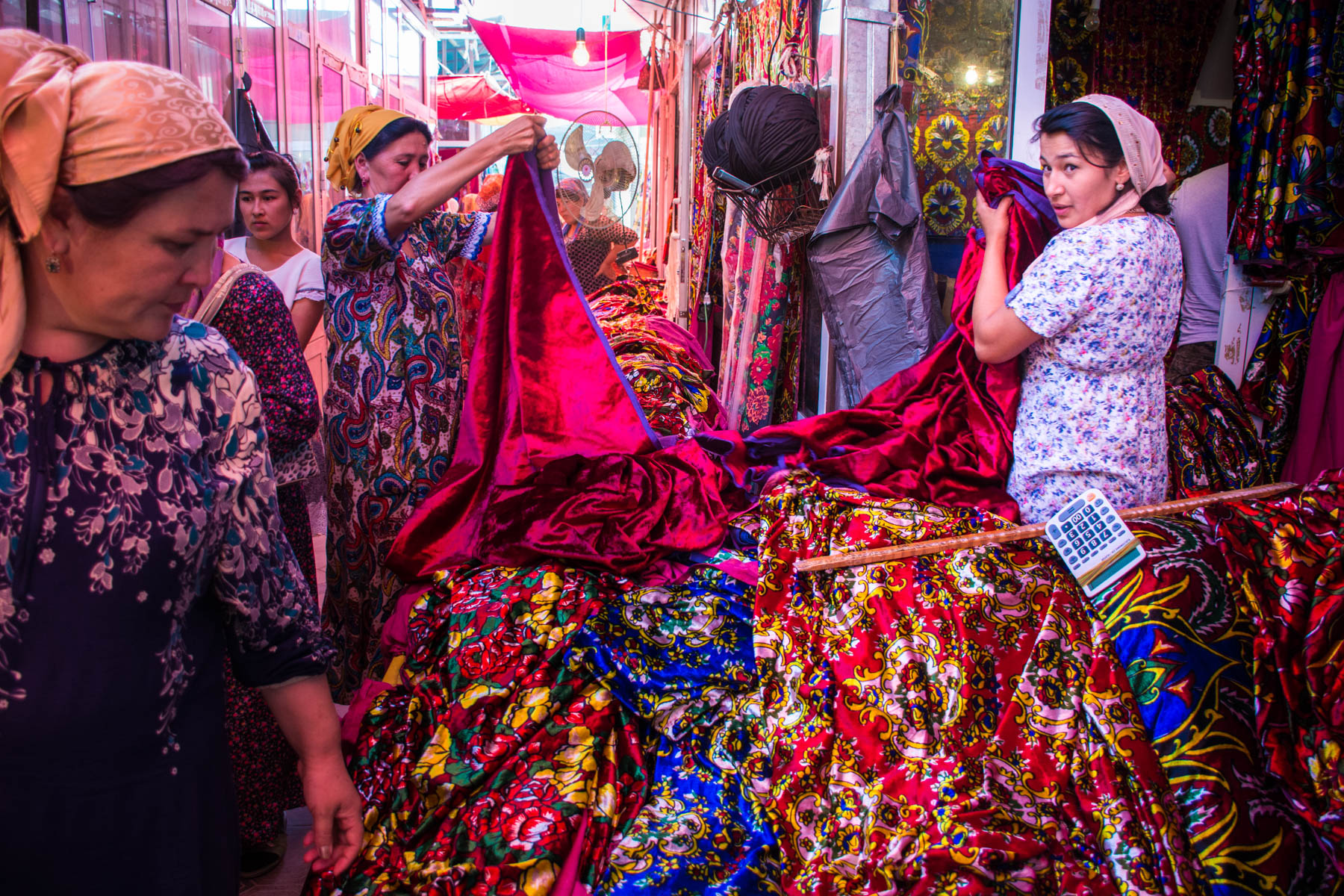
The colorful bazaar of Andijan
Andijan
Andijan, capital city of the Ferghana Valley, lacks any must-see tourist sights. It has a nice bazaar, a decent Friday Mosque, and a destroyed mosque with an incredibly intricate ceiling… but none of these will blow you away.
Andijan does, however, houses some of the friendliest people in the country. Walk around town and you’ll see grinning faces, students trying to up their English game, and a friendly stranger or two who’ll invite you for dinner (and maybe a homestay, but alas, not allowed). Andijan is also a decent base from which to explore the rest of the Ferghana Valley.
Note: Due to government concerns, you’ll need an accommodation slip for each night you stay in the valley. Couchsurfing or camping is not recommended here.
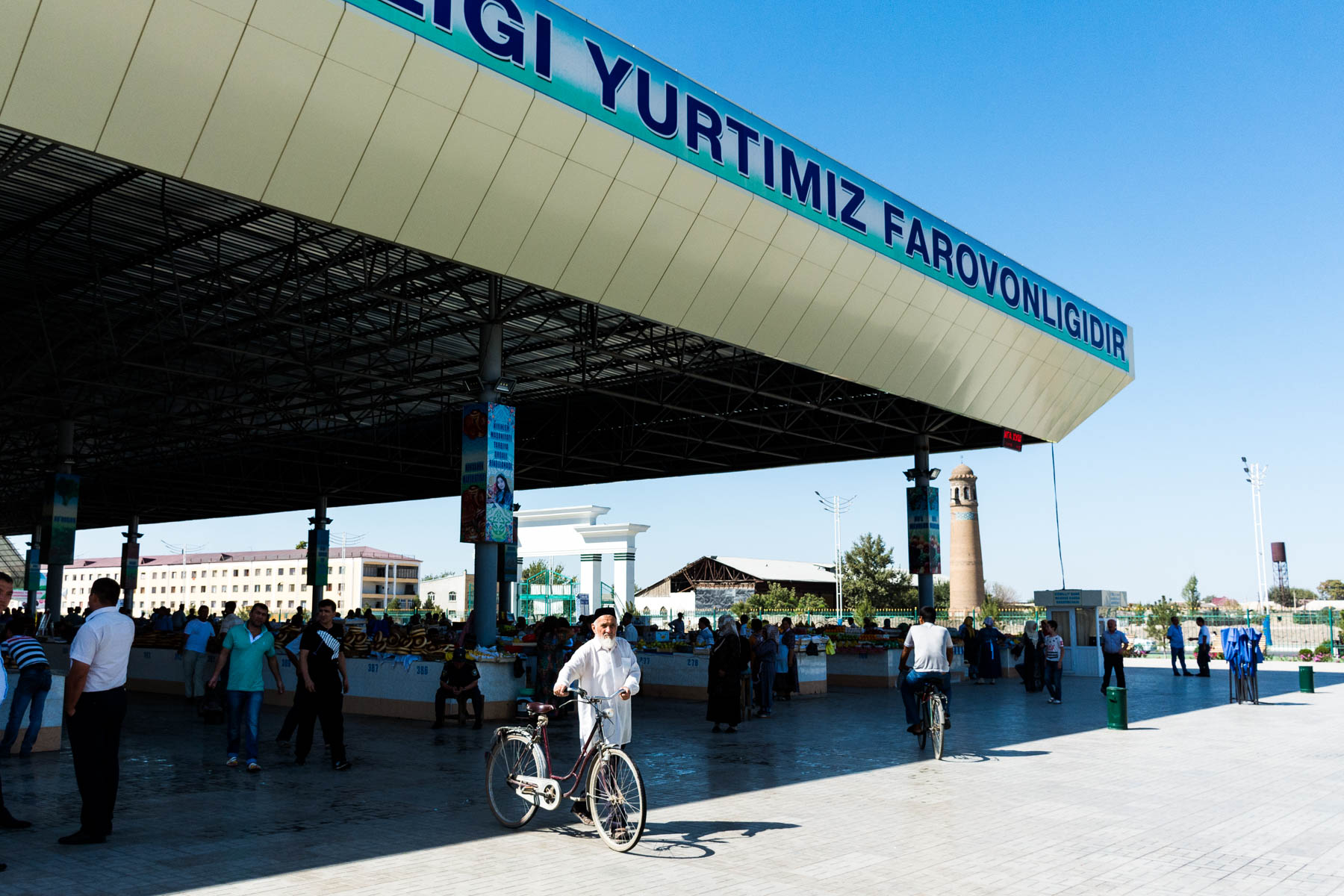
The food-filled Eski bazaar
Top things to see in Andijan
- Jama Mosque: If you visited any of the places mentioned in the main itinerary, Andijan’s Jama Mosque is probably a letdown. Regardless, the gatekeeper is friendly, and more than willing to tell you about the mosque’s history.
- Nameless mosque: Not far from the Jama mosque (to the right, if you’re facing it) and across from the Eski Bazaar, is something that looks like a construction site. It has a debilitated minaret, and you wouldn’t normally walk over. I implore you to do so, though—the ceiling won’t disappoint!
- Andijan bazaar: Every Sunday and Thursday Andijan’s bazaar springs to life. It’s a great place to wander around and chat with some local people.
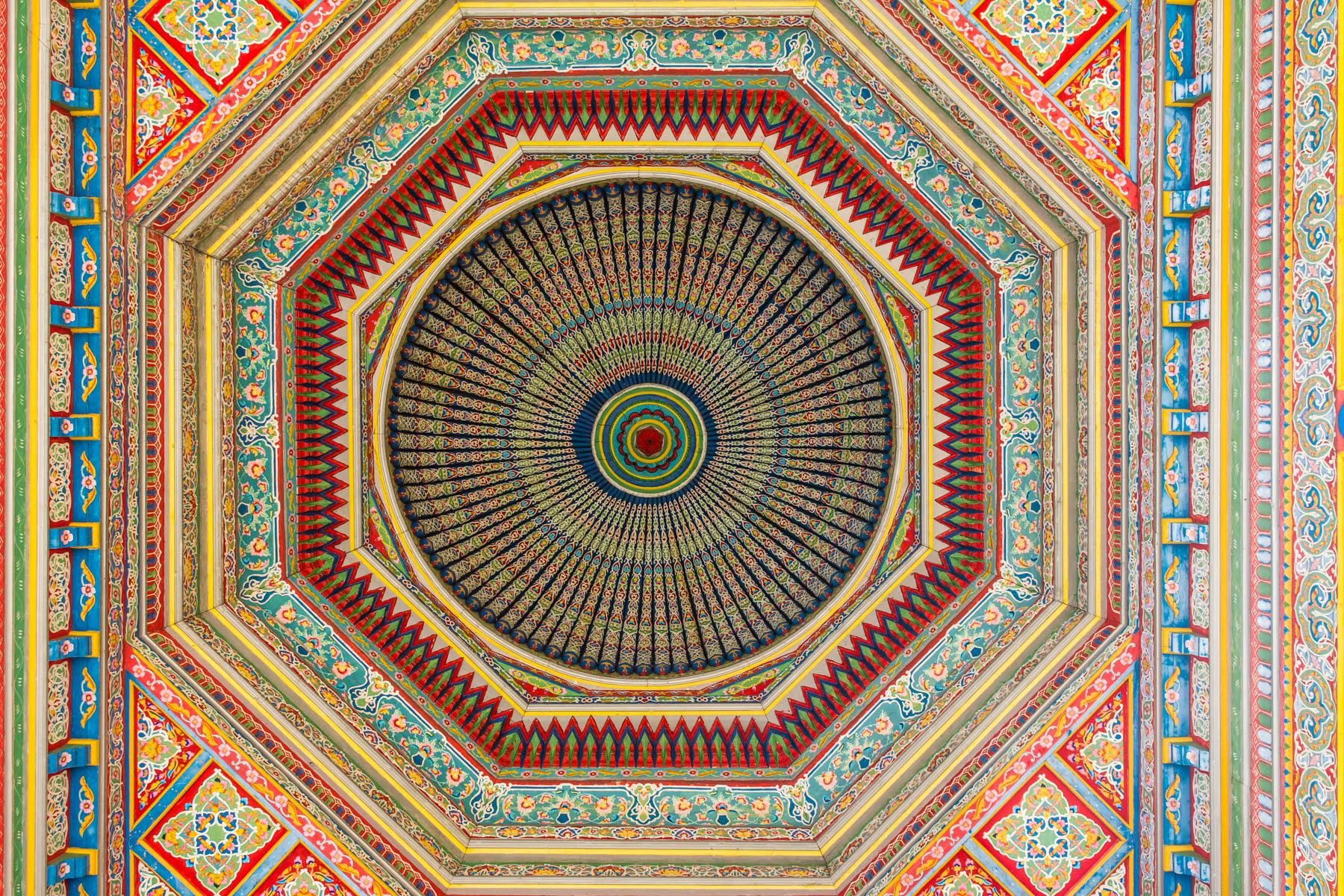
The epic ceiling of the nameless mosque
Where to stay in Andijan
- Budget/mid-range: Andijan Hotel. It’s hard to find info online, but it’s centrally located, and all taxi drivers will know it. Don’t be deterred by the stateliness of it, budget travelers—it’s reasonably priced, especially for Uzbekistan.
- Luxury: Bogishamol Hotel – Check out Bogishamol Hotel now
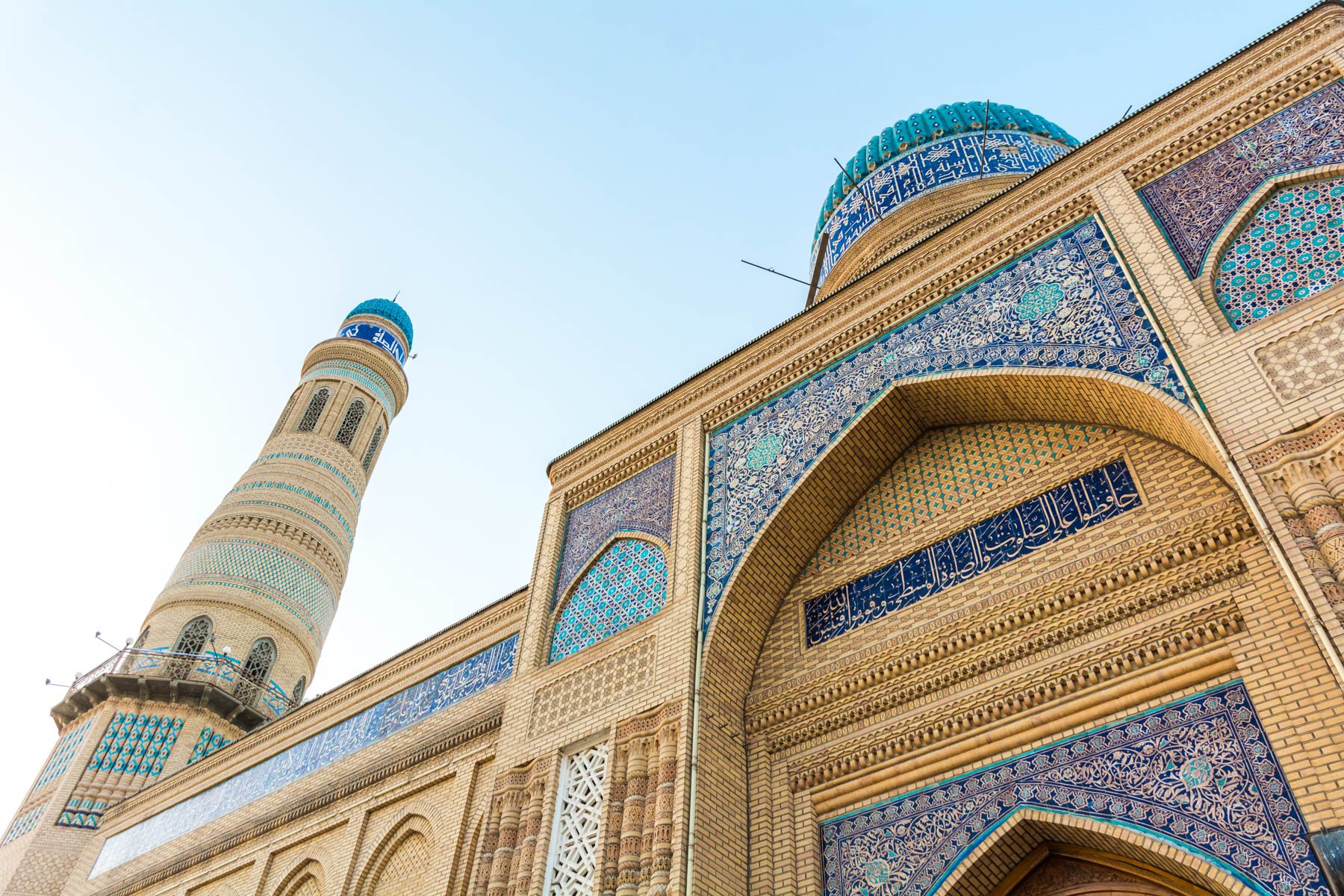
Andijan’s towering Jama Mosque
Transportation from Andijan
It used to only be possible to travel from Andijan to Tashkent by shared taxi, but that has changed with the arrival of a new train station and train line.
- Shared taxi to Tashkent: 4-5 hours (see how to get from Andijan to Tashkent by shared taxi at the end of this post)
- Train to Tashkent: 6 hours
Termez
Like Andijan, Termez doesn’t have any must-see sights inside the city. It does have some places of interest nearby—such as ruins of an ancient Buddhist stupa—and you can see Afghanistan from parts of the city. Not many tourists make it there, and Termez has a Wild West feel to it.
Only recommended if you have time to spare, or if you’re heading to Afghanistan. John B Around the World has a great guide to Termez.
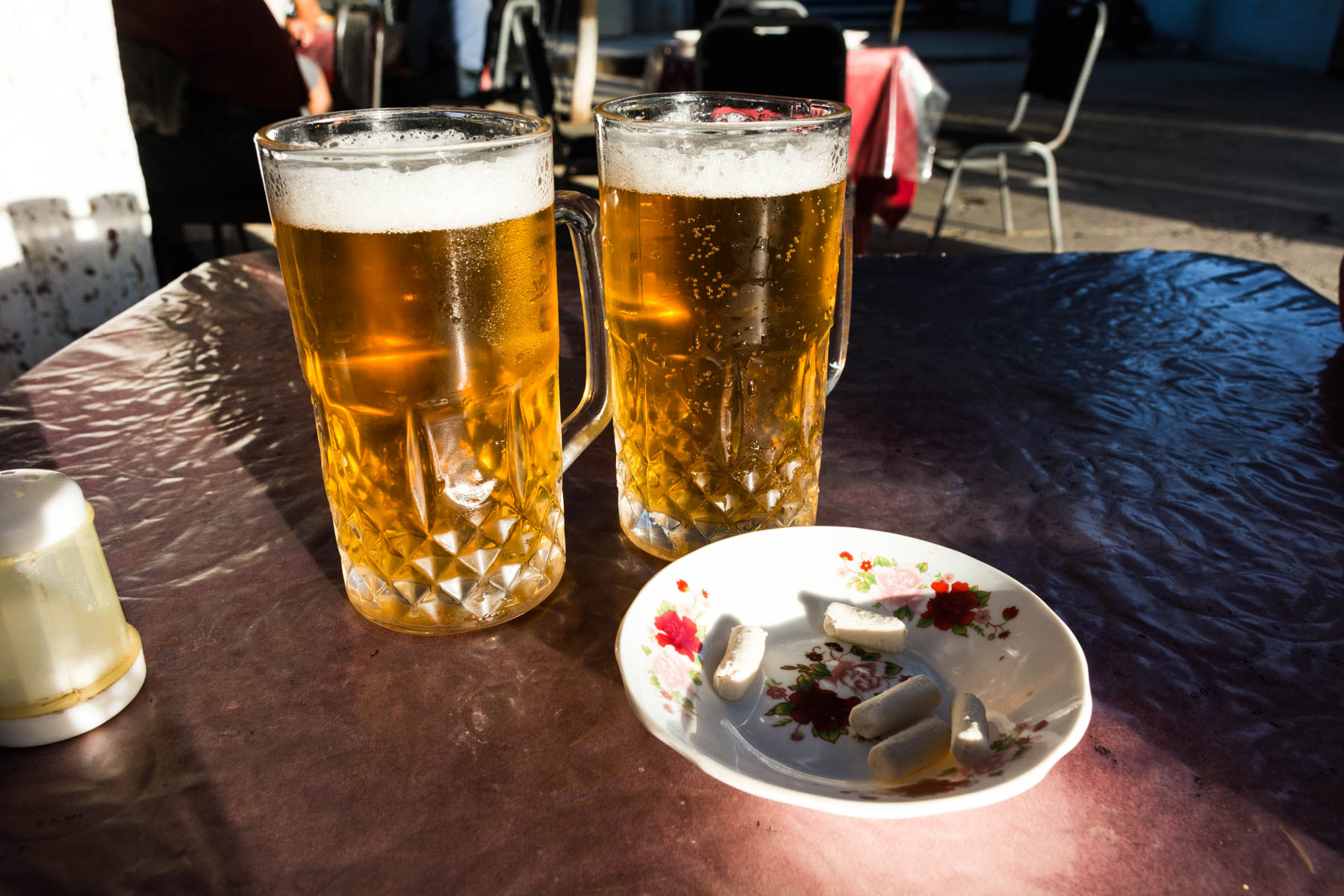
My last beer at a streetside barbecue joint in Termez before heading to dry Afghanistan.
Top things to see in Termez
- Mausoleum of Al Hakim At-Termizi: Nowhere near as impressive as other mausoleum’s in the country, it’s still an interesting place to visit.
- Kirk Kiz Fortress: A little out of town, this fortress is fun to rummage around in for a bit.
- Sultan Saodat Ensemble: Not as grand as the ensemble in Samarkand, but still quite beautiful and definitely worth a visit when in Termez.
- Fayaz Teppa – Kara Tepa – Zurmala Stupa: Some of the last remaining Buddhist holy places in the area.
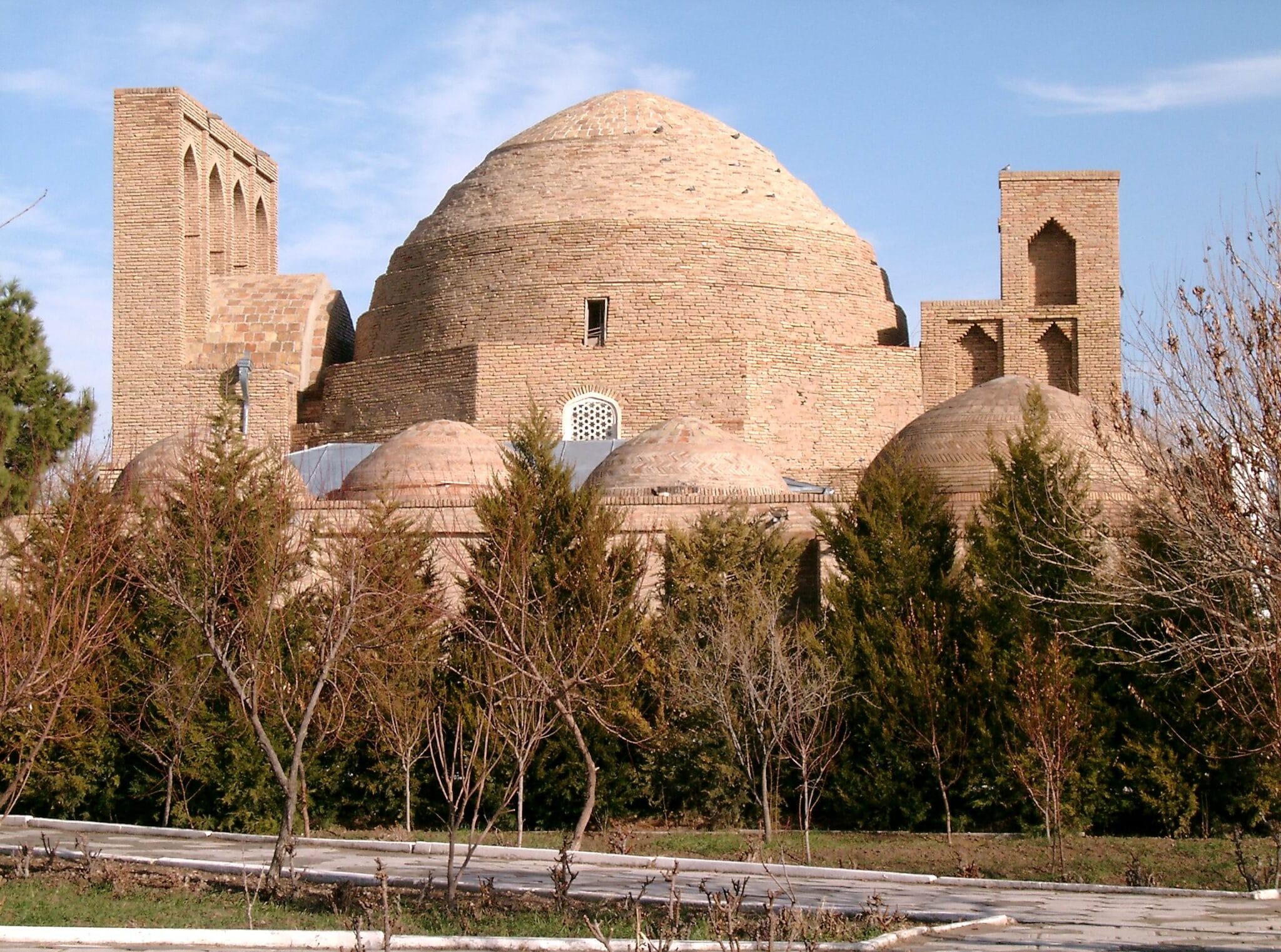
Khakim-at-Termezi complex near Termez
Where to stay in Termez
- Budget: Surhan Atlantic
- Mid-range/top-end: Meridian Termez
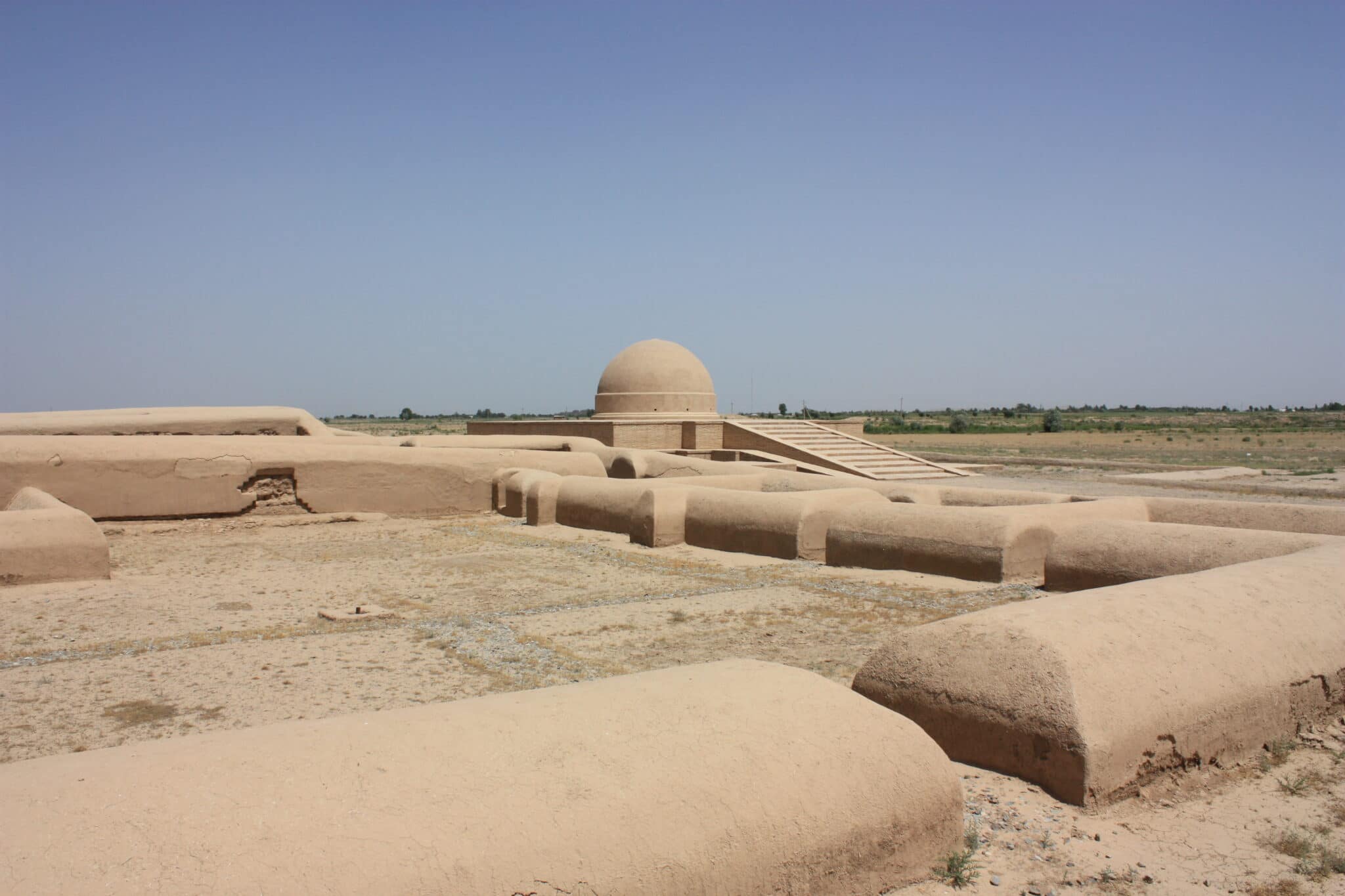
Fayoz-Tepe by Arian Zwegers
Transportation from Termez
- Train to Tashkent: 14 hours
- Train to Samarkand: 10-11 hours
- Shared taxi to Samarkand: 6 hours
If you’re going to Afghanistan, check out my Uzbekistan – Afghanistan border crossing report here.
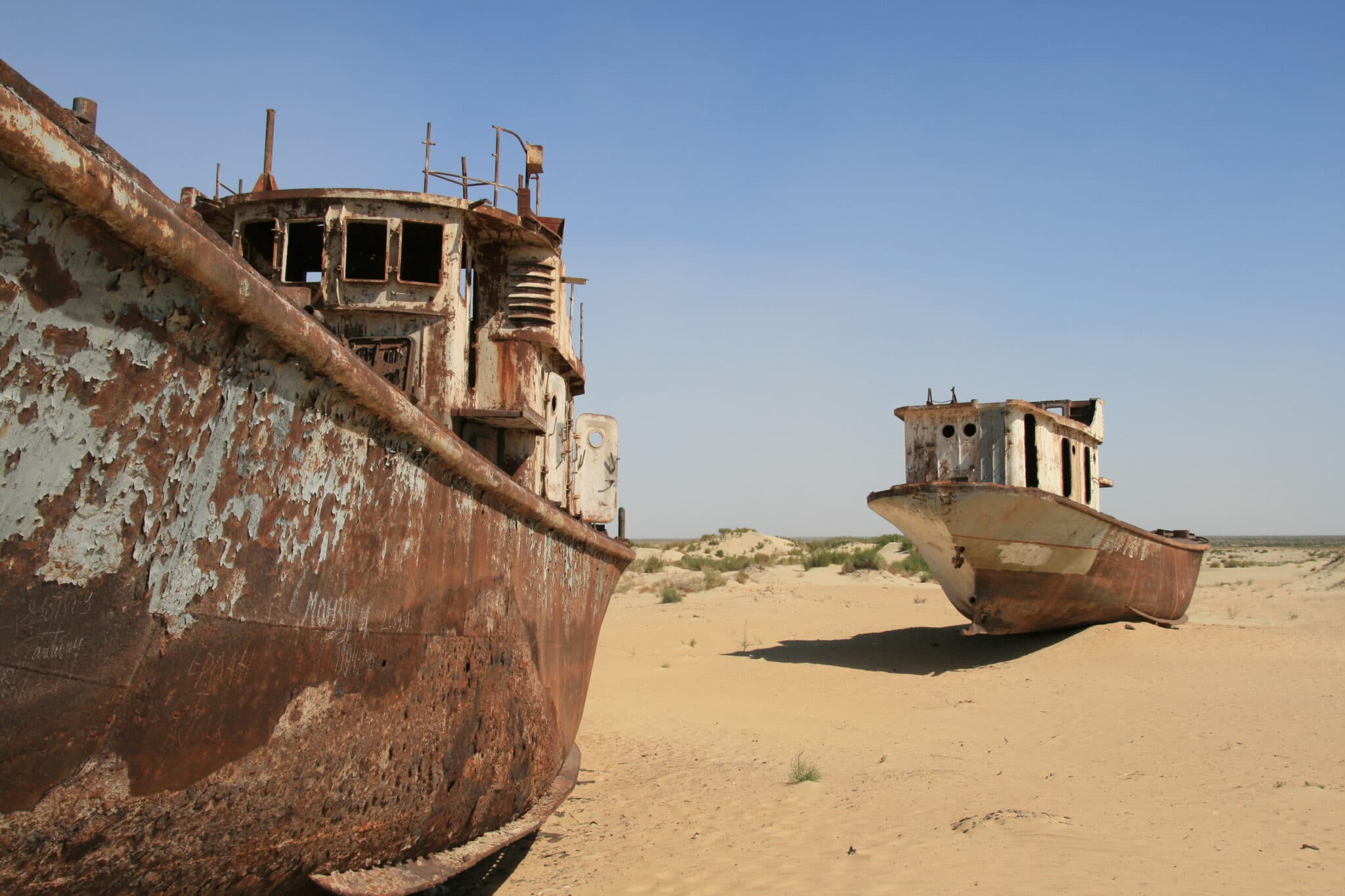
Abandoned boats on the dried-up Aral Sea by kvitlauk
Aral Sea
The Aral Sea is a testament to how human greed and poor planning can destroy the environment in a nearly irreversible way, and many people visit Uzbekistan just to see it.
Uzbekistan’s huge cotton industry has bled the sea, which the country shares with Kazakhstan, nearly dry. Kazakhstan is trying to fill the sea back up, but the water coming in is siphoned off again to the cotton fields of Uzbekistan. A saddening, but eye-opening, trip.
Moynaq, a small fishing village that used to be on the edge of the sea, is the easiest place to witness the current state of things. It’s best done as a day trip from Nukus, as it’s only a 3-hour drive away.
Practical guide and resources for traveling in Uzbekistan
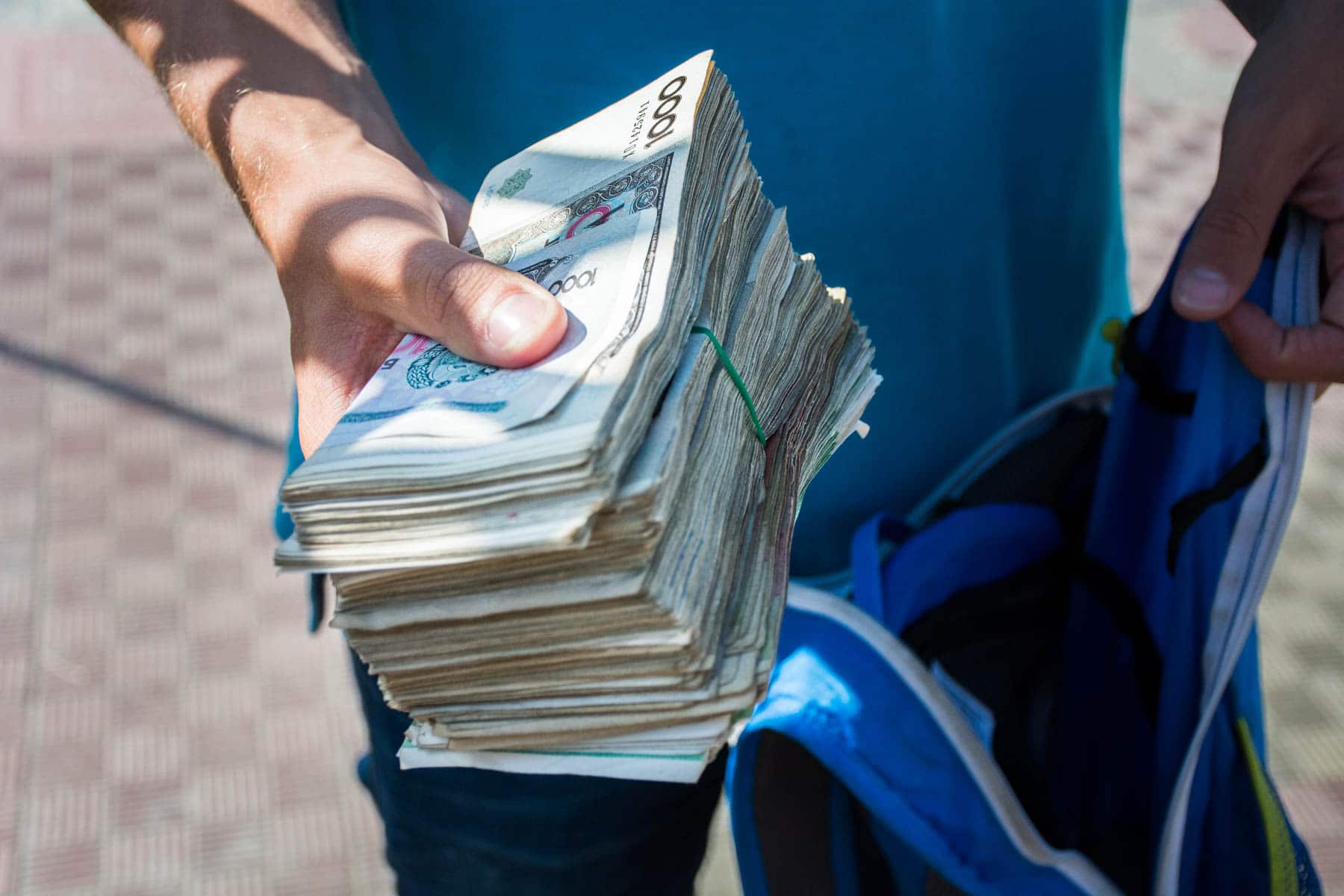
$100 in Uzbek som back in 2016. Luckily, things have changed since then!
Money in Uzbekistan
Traveling to Uzbekistan comes with some quirks. It’s a cash-only economy, meaning your cards are often useless except in high-end hotels.
Money used to be a nightmare; you had to carry around huge stacks of bills and change foreign currency on the black market for the best rates. Luckily, the Uzbek government has done away with its restrictive currency policies, effectively killing the black market for money. It also printed large denomination notes; you no longer need a backpack just to carry around your Uzbek som!
Money can now be changed at market rates at Uzbek banks and exchanges. ATMs are more widely available in Tashkent and Samarkand, and should convert money at market rates. I still advise bringing cash when you visit Uzbekistan; ATMs can run out of money quickly.
Unless you’re going with a tour that has arranged everything for you (doubtful if you’re reading this), you’ll have to bring cash. Cold hard US dollars are the currency of choice—make sure they’re in somewhat good condition—but other currencies are accepted, too.
For more information on the money situation and how to exchange money in Uzbekistan, check out my post on how much it costs to go backpacking in Uzbekistan.
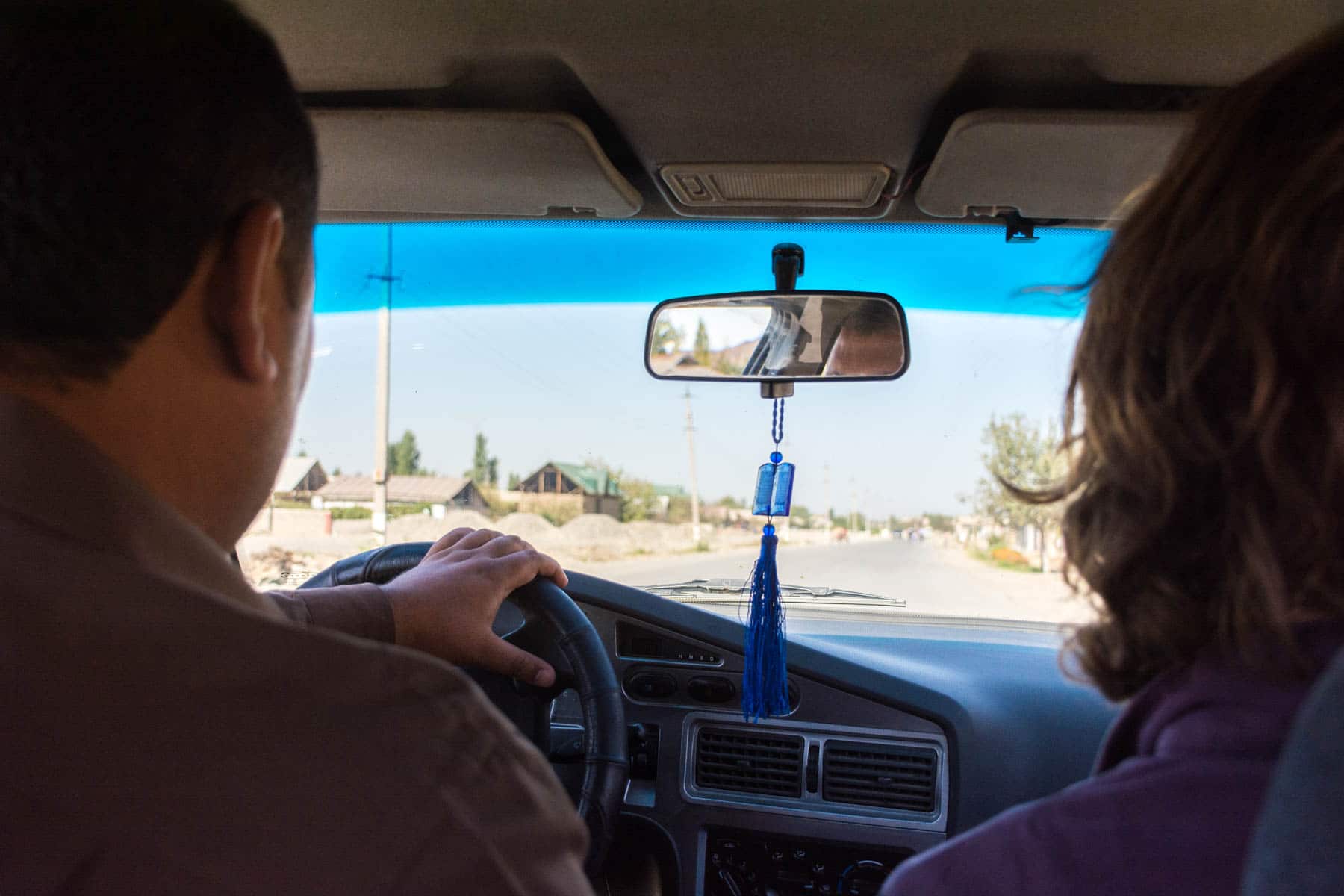
A shared taxi in Uzbekistan
Transportation in Uzbekistan
Uzbekistan isn’t huge, but getting around can be time-consuming. The most common means of transportation between cities are trains and shared taxis.
Shared taxis in Uzbekistan
Shared taxis have set places of departure, and leave when full. To find shared taxis, ask your guesthouse where the shared taxi for your destination leaves from, though regular taxi drivers usually know, too.
In some cases, bargaining for a shared taxi is straightforward. Ask your guesthouse what the going rate is, and offer that to the taxi driver. They usually agree quickly if the price is fair.
Tip: Sometimes, shared taxi drivers will rush you to leave before their car is full, then make you pay for all the seats, not just yours. If it seems your taxi driver is trying to take advantage of you, simply put your bags in the car then stand outside the car until it’s clear that it’s full with other passengers.
Routes to less-visited places, such as Termez and Andijan, however, can have very stubborn drivers who refuse to give you a good price. Your best bet is to wait for locals to arrive and have them help you negotiate a price. Make sure to pay attention: drivers will sometimes ask them to overstate the price so they can charge you more.
Drivers will usually drop you off in front of your guesthouse or your desired destination.
Trains in Uzbekistan
Trains are more comfortable than shared taxis, and are definitely the way to go for long distances.
Uzbekistan has fast trains and slow trains. The fast trains, which only run during the day, are modern affairs, priced accordingly. Slow trains, which also run overnight, consist of old Soviet rolling stock. Uzbekistan recently introduced the Afrosiyob high-speed rail, which runs between Tashkent, Samarkand, and Bukhara. It’s the most expensive, but by far the fastest transportation option.
The times I mention in this itinerary (except the train to Termiz) are mostly for fast trains. Slow trains take at least twice as long.
I only used slow trains. They are much cheaper, and though the ride is long the conversations you’ll have with curious Uzbeks help to pass the time. They also help you save on accommodation costs, since fast trains don’t go overnight. Most slow trains offer three types of seating:
- Platzkart
- Kupe
- SV
Platzkart is an open wagon, with two beds to the side and four beds across from each other in each section. Kuppe has four-berth wagons and SV two-berth wagons. I preferred platzkart, as it’s cheap, comfortable enough, and a great place to meet locals.
You can (theoretically) book tickets online these days on the Uzbekistan Railways website, but I found it much easier to just go to the train station or a ticketing office a day before departure. Guesthouses can help with bookings, too. Seat 61 has a more extensive guide to trains in Uzbekistan.
Tip: If you take the train, make sure to arrive at the station at least half an hour before departure. You need to go through a security screening before reaching the platform.
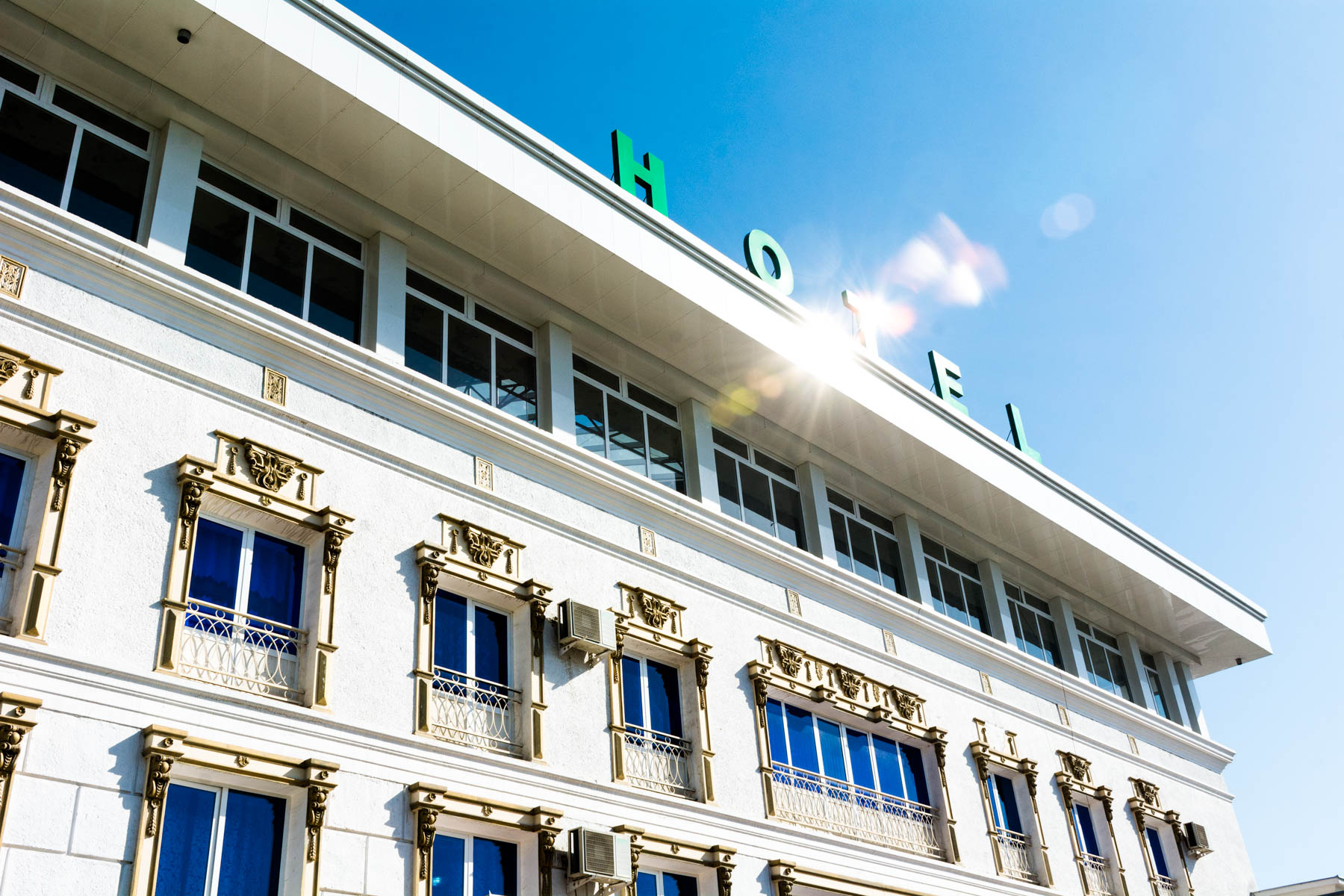
Soviet-style hotel in Andijan
Accommodation in Uzbekistan
Since Uzbekistan has a bit of an obsession with control, they like to make sure foreign visitors stay in official lodging. To enforce this, hotels, guest houses, and hostels are required to register with the government, report each foreign visitor that stays, and provide a registration slip as proof.
Theoretically, all tourists visiting Uzbekistan have to present all these registration slips upon departure from Uzbekistan. However, in recent years border officials have become more relaxed about seeing every. single. slip. Officially you need have at least one proof of registration for every three day period—meaning you could disappear for the other two days—but not all officials seem to care. The exception is the Fergana Valley, where you do need to register every day.
If you’re staying in a hotel, guest house, or hostel, everything will be arranged for you. Just make sure to keep all your registration slips in a safe place. Camping and Couchsurfing are much trickier propositions, which I don’t recommend since you can put both yourself and your host at risk of punishment. If you’re taking a night train, keep the ticket as proof of “accommodation.”
In my experience in 2019, border guards seem much more relaxed about the need to register and mostly wave tourists through. However, I still recommend you keep your registration slips, just in case. You never know when you’ll get a stickler at customs and immigration.
More resources for travel in Uzbekistan
- Things to know before going to Uzbekistan – My go-to list of all things you need to know before traveling to Uzbekistan.
- Lonely Planet: Central Asia – Because let’s face it, having a physical book is always best. This is the most up-to-date Lonely Planet with Uzbekistan coverage.
- World Nomads Travel Insurance – The travel insurance I used both times I visited Uzbekistan. Highly recommended!
- Uzbekistan? Overchargistan! – A look at the unfortunate practice of overcharging in Uzbekistan by Uncornered Market, one of my favorite blogs.
Interactive route map of places to visit in Uzbekistan
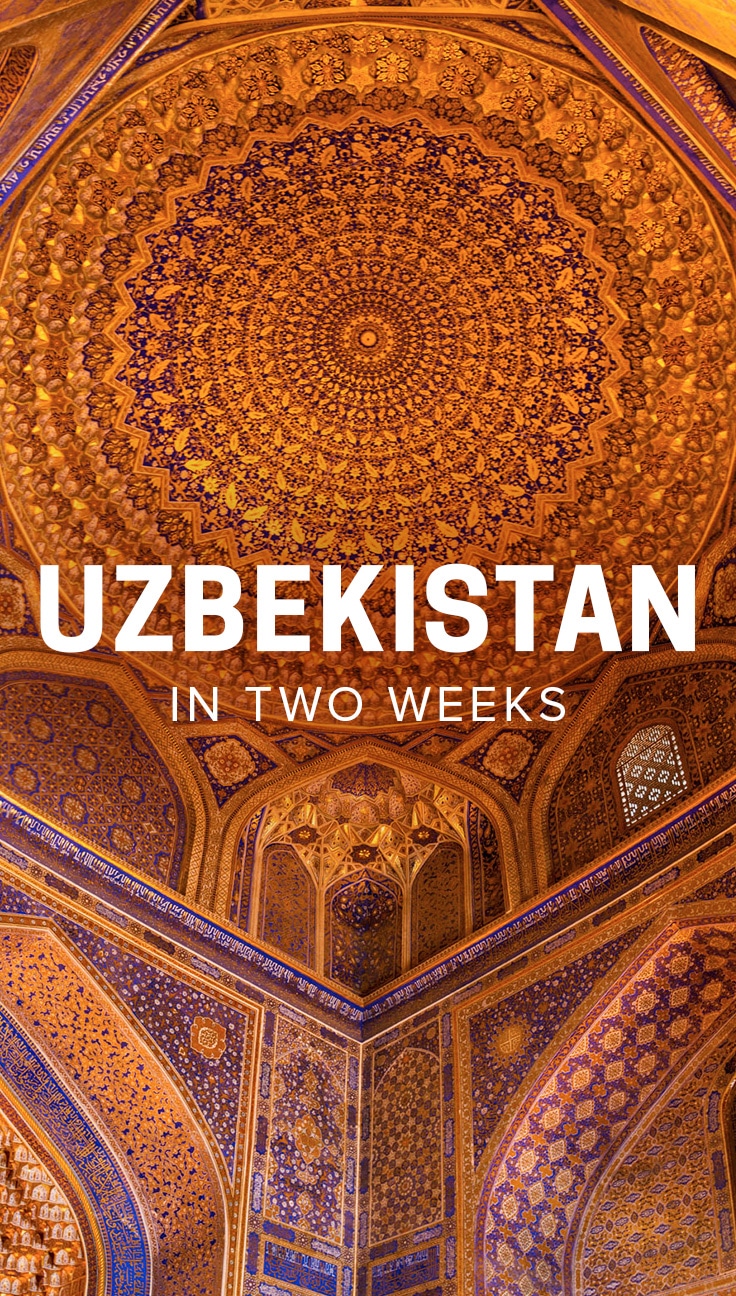
Was this helpful? Pin it!
Yay transparency! Some of the links in this post are affiliate links. If you buy or book something with my links, I’ll get a small commission at no extra cost to you. Think of it as a way of saying thanks for making the itinerary 🙂
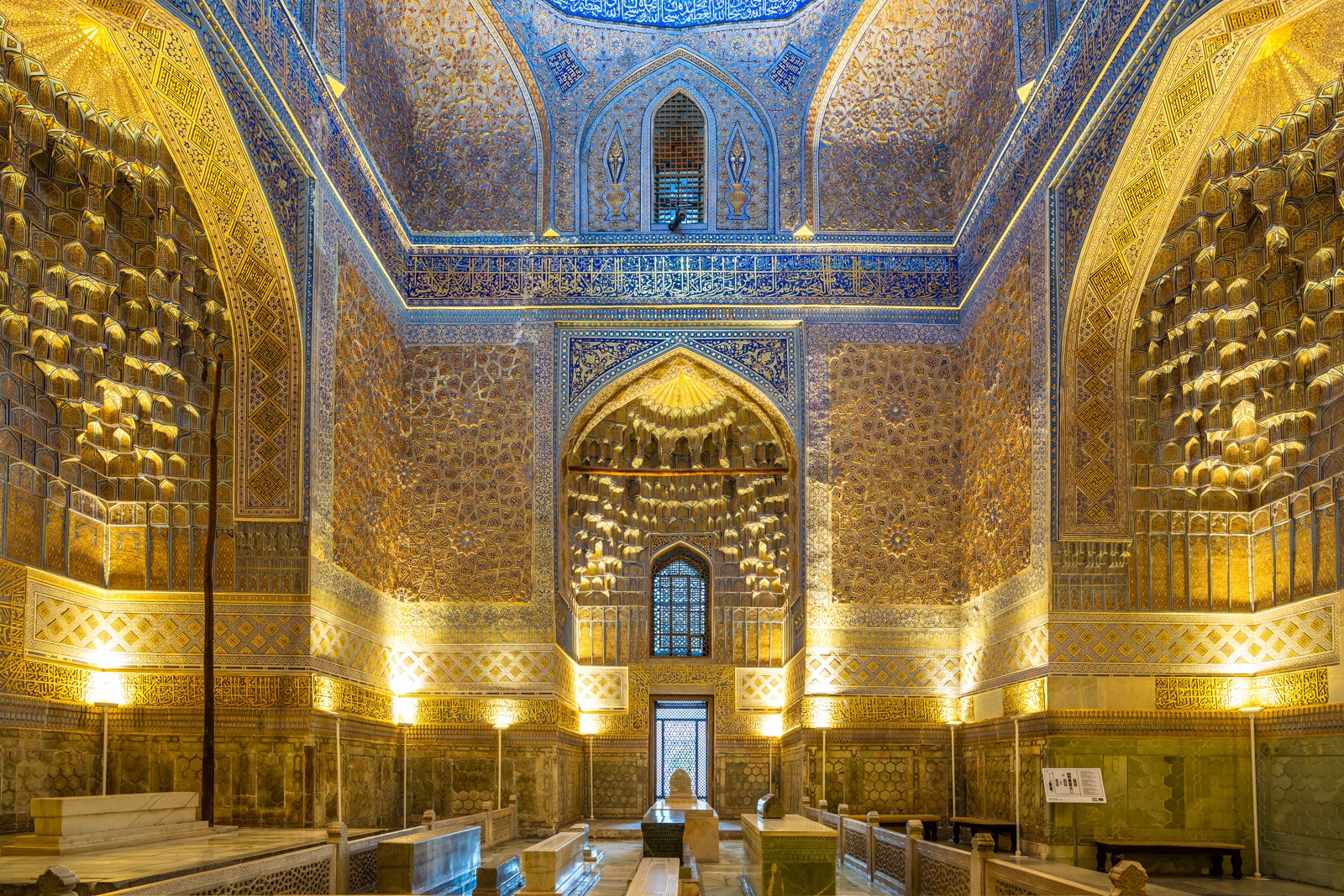


The pictures are stunning and the info is fantastic!! Thanks for sharing. I’m headed to Uzbek with my family (kids will be 5 &6) this summer, so this is incredibly helpful!!
Awesome! Stay cool in the summer months 😉 We hope your kids will enjoy it, too. They’re sure to get plenty of attention from Uzbeks!
Your blog is amazing and it reminds me of my 2 week long solo trip through Uzbekistan (pretty much where you went, except I didn’t do Termez and Andijan and did the Nurata Mountains instead) in 2013. I am also a twenty-something who has traveled a fair bit, and I truly think that was my best trip by far. The people were unexpectedly nice and warm, despite not speaking the same language and it was such a mix of cultures and influences. Can’t wait to explore the rest of Central Asia – Keep ’em posts coming and tempting more people like me!
Thank you for the kind words. Uzbekistan really is an amazing place. Hope you get to see more of Central Asia soon. Cheers!
Uzbekistan is a great experience. No doubt, Bukhara is one of my favourite places in Asia, if not the world – such a great place to wander and get lost, just like you suggested! Judging by your picture, I think I might have eaten at Chasmai Mirob too – what a view!
We understand why. So much history and such a great place to get lost in.
Heey,
Its really nice to see your pictures about your holiday. I have read al your information. Its so lovely to see the people on the pictures. its olso nice to see pictures that you have taken in Uzbekistan. I can understand that you want to make this rice en this blog. It was fantastic to read.
Glad you like our blog. Thanks for tagging along for the ride!
I recently discovered your blog and am enjoying your posts and the beautiful photos. I think your info is both thorough and focused; perfect after reviewing an area or country guidebook. Over the past 6 years I’very spent nearly 3 months in Uzbekistan. I volunteered to work with graduate students on English technical writing. I was based in Tashkent but also traveled around the country. It was all terrific and I actually had amazing adventures and experiences in the city. I met wonderful people through the students. I carried a fold-up wall map of the U.S. and a small photo album of my home state, Montana. I was always in a friendly conversation.
Really glad to hear that. And that must have been an amazing experience. Uzbeks are really friendly, so I’m sure you were treated well. And they really seemed to like Americans. Cheers!
We really missed your two week tour to uzbekistan. Nice have you visited us? ELITETRAVELS.CO.UK
Hey
People in Uzbekistan speak the Uzbek language. The linguistic diversity of Uzbekistan is diverse according to a fractionalization scale which for Uzbekistan is 0.412. The followers of Islam are the religious majority in the country. 36.2% of Uzbekistan’s population live in cities.
Nice chace
I recently discovered your blog. Thanx Alex for your overview of your travel to Uzbekistan and amazing photos. In recent years Uzbekistan makes efforts to promote tourism and attract more international tourists. Experiences and info sharing like yours help to attract more tourists to our country. If u visit Tashkent again I would be happy to treat you with plov(traditional Uzbek dish) 😉